Take Me to the Recipes
Palestine, located in the heart of the Middle East, boasts an incredibly rich history, stunning landscapes, and a unique cultural tapestry. One of the treasures this region has to offer the world is the Palestinian cuisine, an exquisite blend of flavors and stories.
The typical climate varies from Mediterranean along the coast to desert conditions in the Jordan Valley, punctuated by the lush greenery of the highlands. Its breathtaking scenery ranges from ancient cities to olive groves and from the deep blue of the Dead Sea to the expansive Negev desert.
The main industrial activities in Palestine encompass agriculture, particularly olive oil production, as well as textiles and stone-cutting. With a population size estimated at over five million, Palestine is a tapestry of traditions, cultures, and, importantly for our journey today, culinary delights.
Take Me to the Recipes
Palestinian Cuisine – Key takeaways
- Rooted in ancient culinary traditions passed down through generations.
- Uses fresh, locally-sourced ingredients, with olive oil as a staple.
- Combines Mediterranean and Middle Eastern flavors.
- Rich in grains, meats, and fresh vegetables.
- Symbolic dishes that resonate with cultural and historical significance.
- Each dish tells a story of the land, the people, and their perseverance.
Where is Palestine?

Gaza
On the eastern coast of the Mediterranean Sea, Gaza is bordered by Egypt on the southwest and Israel on the east and north.

Index to the Article Contents
- Take Me to the Recipes
- More Articles
- Interesting Facts about Palestinians
- Palestinian History and the Effect it Has Had on the Cuisine
- How Palestinian’s Climate and Geography has Influenced Palestinian Cuisine
- Understanding the Essence of Palestinian Cuisine
- Palestinian Culinary Traditions
- Palestinian National Dish
- Traditional Palestinian Food
- The Most Popular Palestinian Food
- How Healthy is Palestinian Food?
- Great recipes to try at Home
- Conclusion
- FAQ’s
More Article
- North and South American Cuisine – A Culinary Expedition
- Europe Cuisine: Savor the Continent’s Best Culinary Secrets!
- African Cuisine: Discover the Bold Flavors & Global Charm!
- Asian Cuisine Unlock its Secrets – Taste, Health & Global Influence!
Savor iconic Palestinian Recipes – Click on each tantalizing picture to open up the Recipe
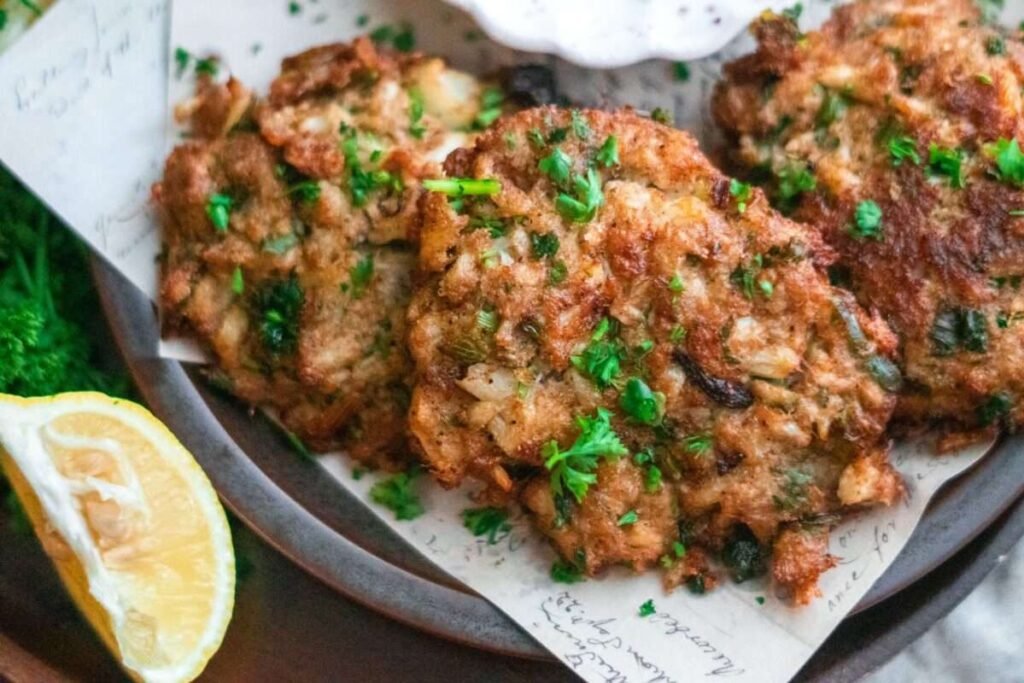
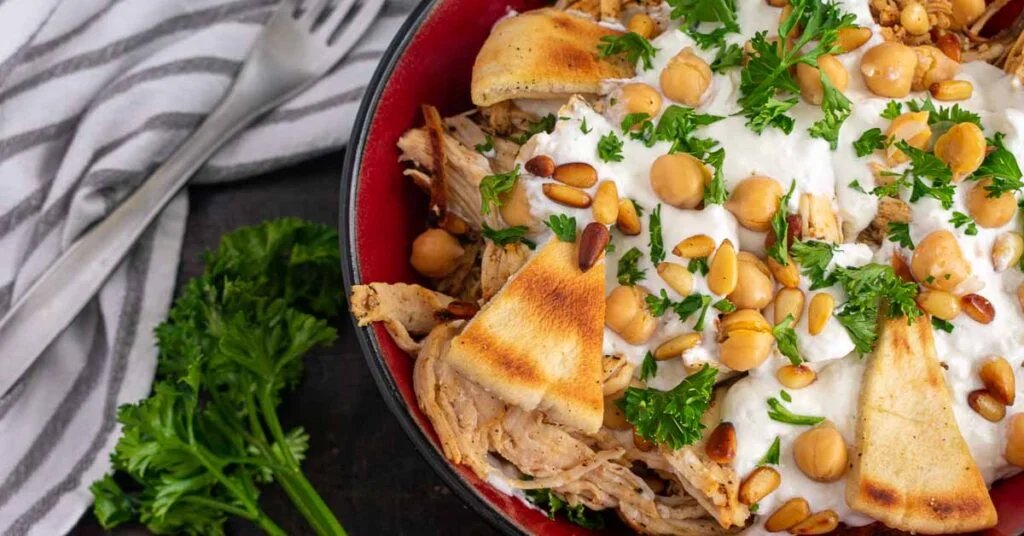
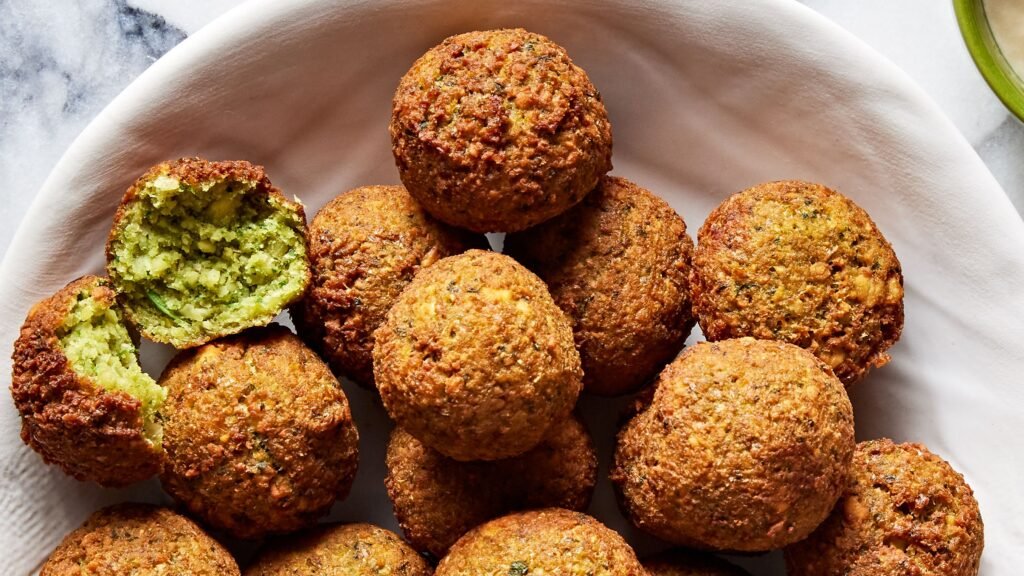








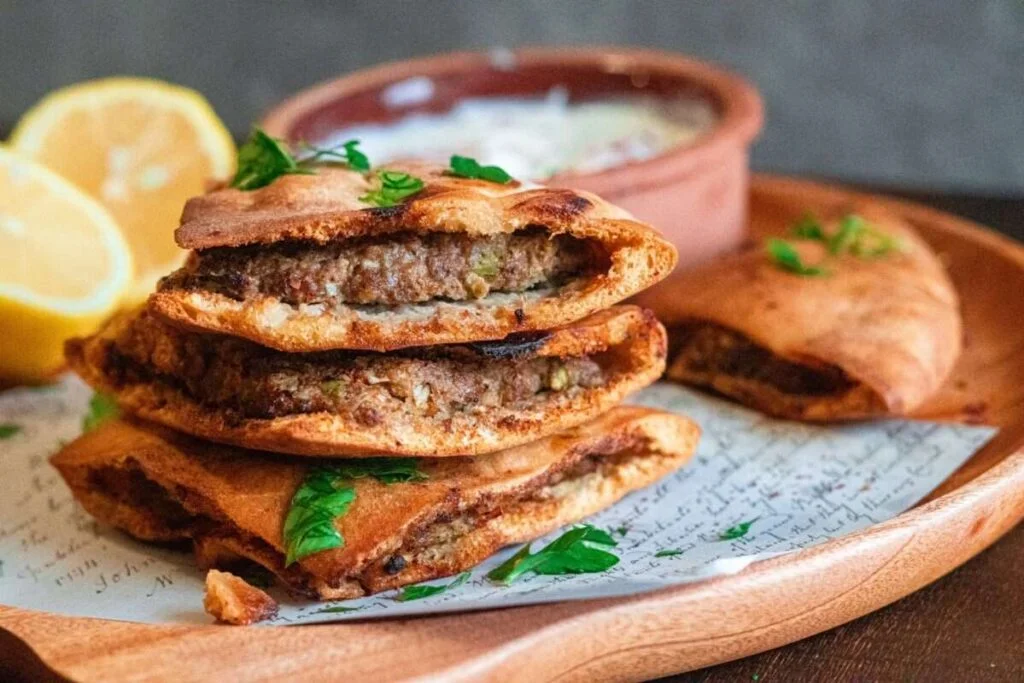

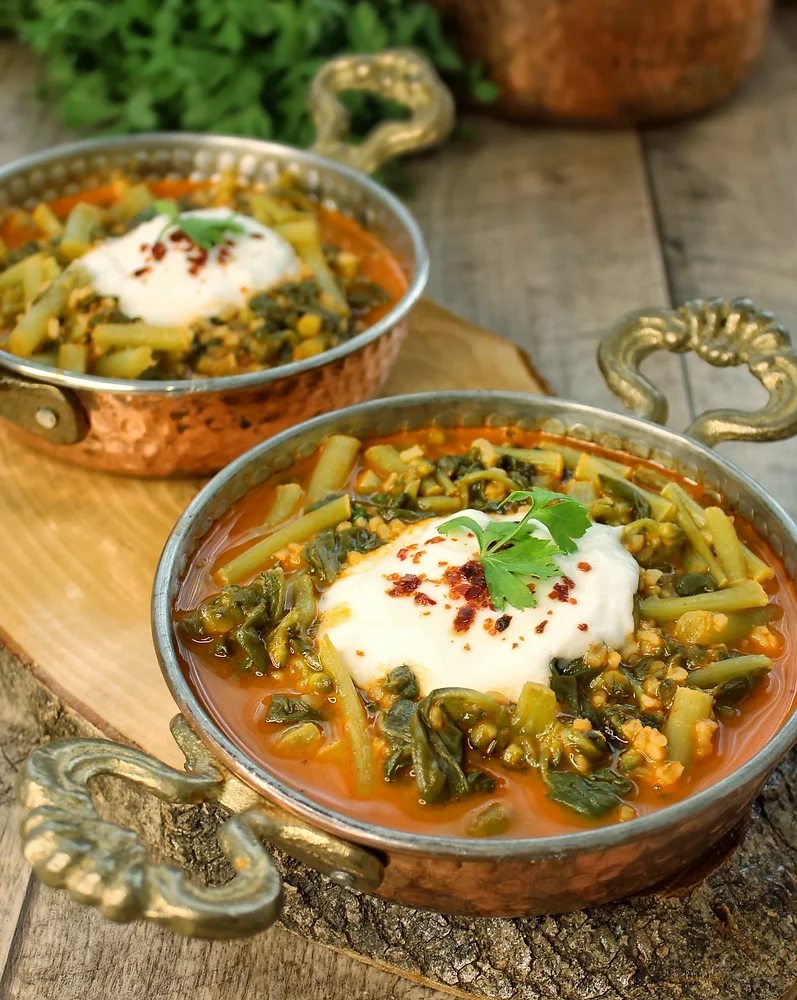
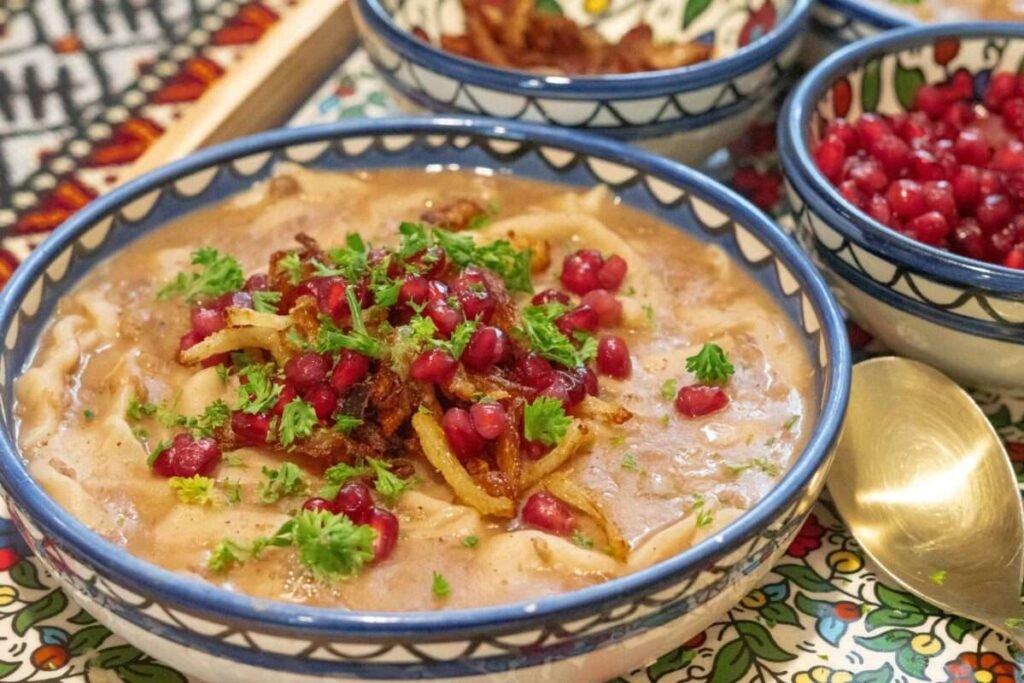
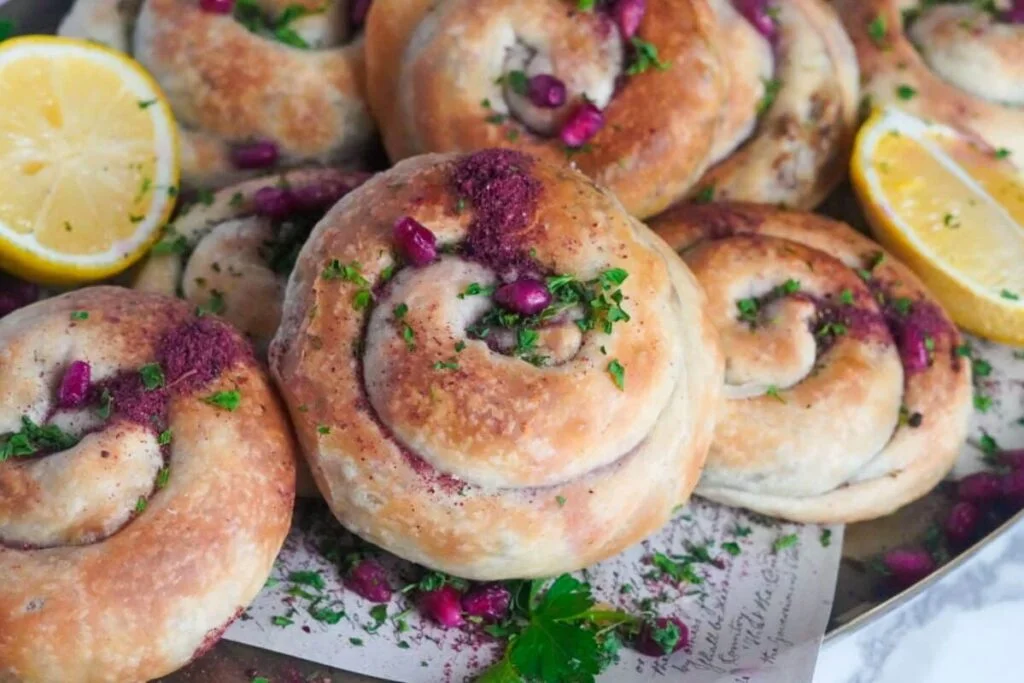
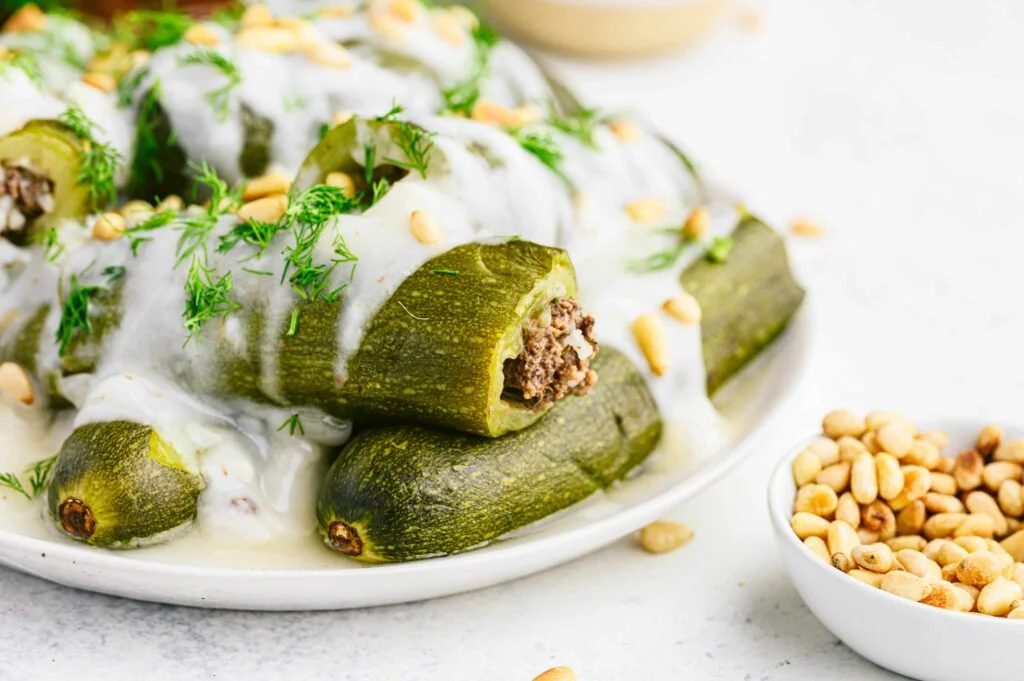
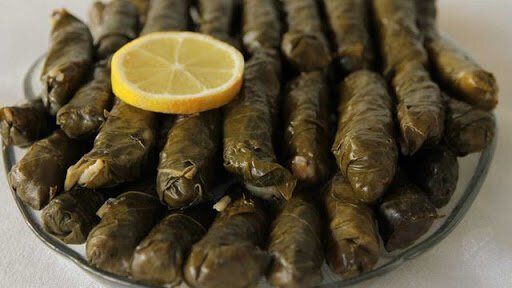

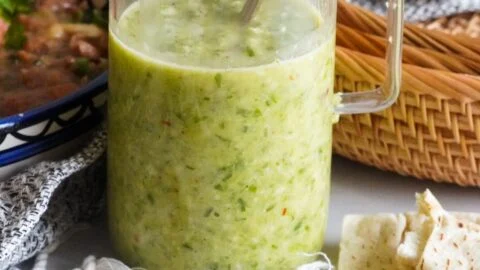
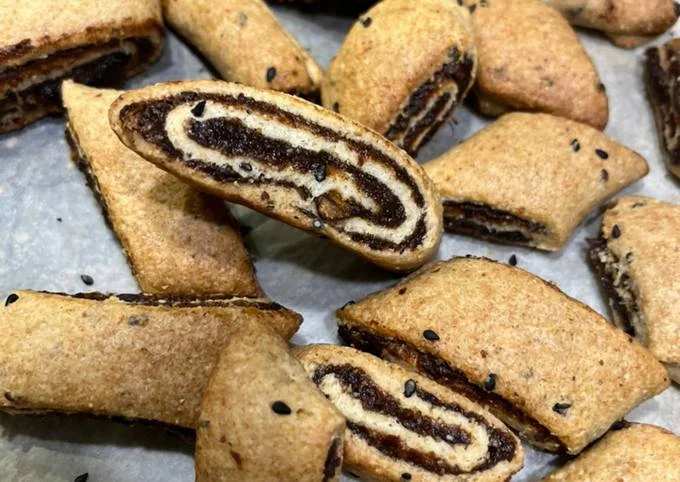
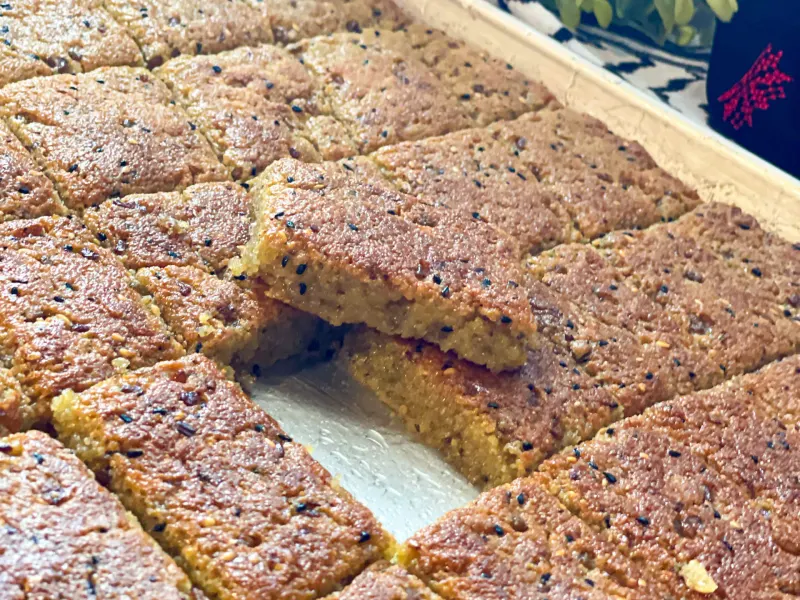
Interesting Facts about Palestinians
The Dead Sea

The Dead Sea is the lowest natural point of elevation on Earth.
Olives
For many centuries, olives have been a significant part of Palestinian life, culture, and tradition. With over 45% of the country’s land dedicated to olive trees, it’s no surprise that they hold a highly revered and treasured place in Palestine’s identity.
Religions
The majority of the population in Gaza is Muslim, but there is also a substantial population of Christians.
The Church of Nativity

The Church of Nativity, considered the birthplace of Jesus Christ, is held as a sacred place by both Christians and Muslims alike. It is also one of the world’s oldest churches.
Palestinian History and the Effect it Has Had on the Cuisine
Palestinian history is a complex and contested topic, as different narratives and perspectives exist on the identity, origin, and rights of the Palestinian people. Here is a brief overview of some of the main periods of Palestinian history and their geographic location, date range, and influence on the Palestinian cuisine:
Note from the author.
After the horrific attacks on the 7th of October 2023 the region has been involved in a bloody war to which there seems little hope if an end. Our hearts go out to the thousands of people in both Israel and Gaza who have been killed, maimed and captured as hostages.
Jolu
These innocent victims are suffering, in what seems like an endless cycle of hate and abuse. We pray that a way will be found for peace in which both sides are able to live without fear!
This site is a simple blog that discusses cuisine around the world, and has no intention of pretending to have any right to discuss the rights and wrongs of what is happening
Ancient Palestine (before 7th century AD)
Palestine was the name given by the Greeks and Romans to the region between the Mediterranean Sea and the Jordan River, which was inhabited by various peoples, including
- Canaanites
- Philistines
- Israelites
- Edomites
- Moabites
- Ammonites
- Nabateans.
These peoples had diverse cultures and religions, such as polytheism, Judaism, Christianity, and Zoroastrianism. They also traded with neighboring regions, such as Egypt, Mesopotamia, Arabia, and Anatolia, and incorporated their crops, spices, and dishes into their cuisine.
Some of the foods that were common in ancient Palestine were bread, olive oil, wine, honey, cheese, yogurt, milk, meat, fish, fruits, vegetables, nuts, and herbs.
Islamic Palestine (7th-16th century AD)

Palestine was conquered by the Arab Muslims in the 7th century, who brought Islam and the Arabic language to the region. They also introduced new foods, such as rice, lentils, chickpeas, dates, citrus fruits, and coffee, as well as dishes that included.
- Hummus
- Falafel
- Tabbouleh
- Fattoush
- Baklava.
They also influenced the preparation and consumption of food, such as the use of halal meat, the prohibition of alcohol and pork, and the observance of fasting during Ramadan. Palestine was ruled by various Islamic dynasties, that included.
- Umayyads
- Abbasids
- Fatimids
- Seljuks
- Ayyubids
- Mamluks
- Ottomans,
Each of these peoples left their mark on the region’s politics, culture, and cuisine.
Ottoman Palestine (16th-20th century AD)

Palestine became part of the Ottoman Empire in the 16th century, and remained under its rule until the early 20th century.
The Ottomans brought Turkish cuisine and culture to Palestine, such as the use of sweets, pastries, and nuts, as well as dishes such as borek, dolma, kibbeh, shawarma, and kebab. They also built modern infrastructure, such as roads, bridges, and aqueducts, and encouraged trade and commerce in the region.
They also imposed taxes and conscription on the local population, and faced resistance and revolts from various groups, such as the Druze, the Bedouins, and the Arabs.
British Palestine (1917-1948)

Palestine was occupied by the British forces in 1917, after the defeat of the Ottoman Empire in World War I. The British established a mandate over Palestine, which was endorsed by the League of Nations in 1922.
The British also issued the Balfour Declaration in 1917, which supported the establishment of a national home for the Jewish people in Palestine, while respecting the rights of the existing non-Jewish communities.
This led to the immigration of thousands of Jews to Palestine, and the rise of the Zionist movement, which aimed to create a Jewish state in the region. This also led to the emergence of the Palestinian nationalist movement, which opposed the British and Zionist policies, and demanded independence and self-determination for the Arab population.
The British also influenced the Palestinian cuisine, such as the introduction of tea, biscuits, and jam, as well as dishes such as fish and chips, and shepherd’s pie.
Israeli-Palestinian Conflict (1948-present)
Palestine was partitioned by the United Nations in 1947, into a Jewish state and an Arab state, with Jerusalem as an international city. However, this plan was rejected by the Arab states and the Palestinian leadership, and a war broke out between the Jewish and Arab forces in 1948.
The war resulted in the establishment of the state of Israel, and the displacement of about 750,000 Palestinians, who became refugees in neighboring countries or within the remaining Palestinian territories.
The war also resulted in the division of Palestine into three parts:
- The West Bank, which was annexed by Jordan
- The Gaza Strip, which was occupied by Egypt
- East Jerusalem, which was occupied by Israel.
The conflict continued in the following decades, with several wars, uprisings, peace talks, and agreements, but without a final resolution.
The conflict also affected the Palestinian cuisine, such as the loss of access to land, water, and resources, the restriction of movement and trade, the destruction of infrastructure and agriculture, and the exposure to new foods and dishes, such as sushi, pizza, and cake.
October Attack by Hamas

The most recent war in Gaza, which started on 9 October 2023 and is still ongoing, has had a devastating impact on the health and food security of the inhabitants.
The war has also destroyed or damaged more than 20,000 homes, 450 schools, 50 hospitals and clinics, and 200 mosques. The war has also destroyed or blocked access to farmland and the sea, which are vital sources of food and income for the Gazans.
It has also increased the risk of famine, malnutrition, disease, and death for the population, especially for children, pregnant women, and the elderly. The war has also disrupted the normal functioning of the society and the economy, and has eroded the social and cultural fabric of the Gazan people.
It has also affected the Palestinian cuisine, such as the lack of availability and diversity of food, the reliance on humanitarian aid and food assistance, the deterioration of food quality and safety, and the loss of traditional and cultural dishes and recipes.
How Palestinian’s Climate and Geography has Influenced Palestinian Cuisine
The climate and geography of Gaza have influenced its cuisine in several ways. Gaza is a coastal enclave that borders the Mediterranean Sea, Egypt, and Israel. It has a hot and dry climate, with mild winters and scarce rainfall. These factors have shaped the availability and diversity of food sources, as well as the preservation and preparation methods of the local dishes.
Some of the main influences of the climate and geography of Gaza on its cuisine are:
Palestinian Cuisine Includes Seafood

Gaza has a long tradition of fishing and consuming various types of seafood, such as sardines, shrimps, crabs, squids, and mussels.
Seafood is often grilled, fried, or cooked in spicy sauces, such as zibdiyit gambari (shrimp in clay pot) or sayyadiyeh (fish with rice and caramelized onions).
Spices
Gaza is known for its use of hot chili peppers (shatta), garlic, and dill, which add flavor and heat to many dishes. These spices also help preserve food and prevent spoilage in the hot climate.
Some of the popular spicy dishes in Gaza are dagga (a salad of tomatoes, chili, garlic, and olive oil), maftoul (a couscous-like dish with chicken and chickpeas), and sumaghiyyeh (a stew of beef, chard, and tahini).
Palestinian Cuisine Includes Vegetables
Gaza has a rich variety of vegetables, such as tomatoes, cucumbers, eggplants, zucchini, okra, and leafy greens. These vegetables are often eaten raw, pickled, or cooked in soups, salads, and stews.
Some of the common vegetable dishes in Gaza are salata ghazawiyya (a salad of tomatoes, cucumbers, parsley, and lemon juice), bamia (okra with tomato sauce and meat), and molokhia (a soup of jute leaves and chicken).
Dairy is Limited
Gaza has a limited access to dairy products and a lack of grazing land for livestock. However, some dairy products, such as cheese, yogurt, and labneh (strained yogurt), are still produced and consumed locally.
Cheese is often made from sheep or goat milk, and is used in desserts, such as kanafa (a pastry with cheese and syrup), or in savory dishes, such as fatayer (cheese pies) or jibneh harra (spicy cheese dip).
Palestinian Cuisine Includes Grains
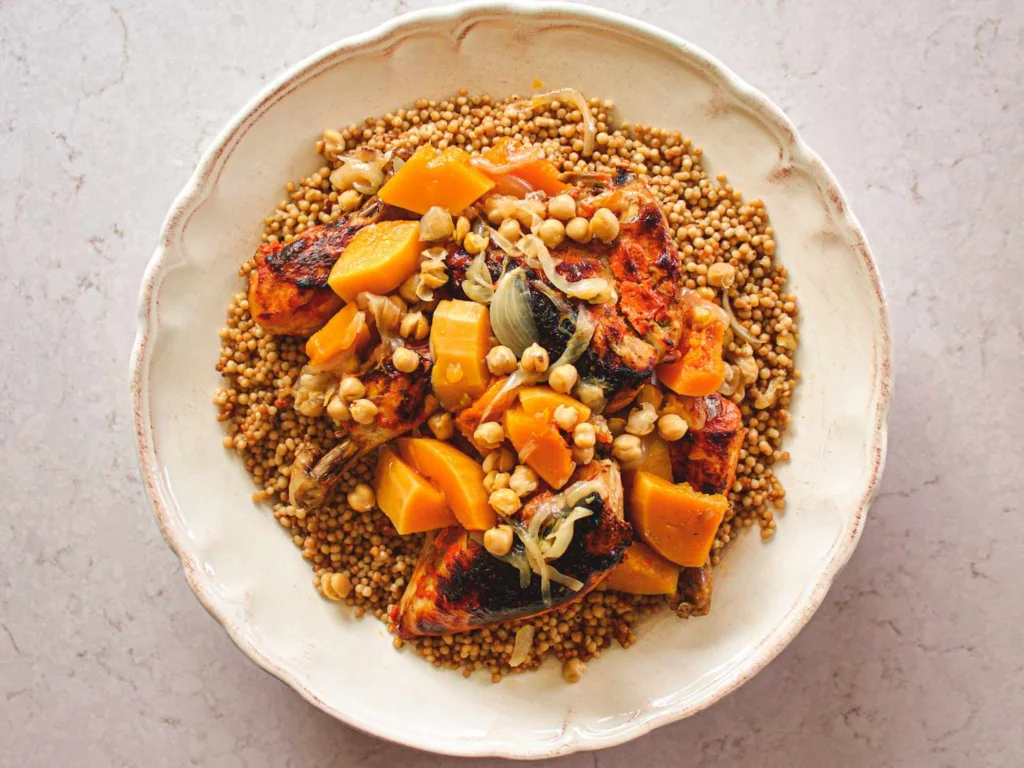
Gaza relies heavily on grains, such as wheat, barley, and rice, as staple foods. These grains are used to make bread, such as saj (a thin flatbread) or khobz (a round loaf), or to accompany meat and vegetable dishes.
Rice is often cooked with spices, such as cumin, cardamom, and cinnamon, and mixed with meat, nuts, or dried fruits, such as in makloubeh (a rice dish with eggplant, cauliflower, and chicken) or qidra (a rice dish with lamb and chickpeas).
References
Understanding the Essence of Palestinian Cuisine
Palestinian cuisine is a mosaic of flavors, textures, and stories, woven together by centuries of history, cultural interactions, and the indomitable spirit of its people. To grasp its essence is to embark on a journey through time and taste.
Central to Palestinian food is the olive tree. Its fruit and oil are not just ingredients but symbols of endurance and rootedness. Olive oil drenches tabbouleh salads, hummus, and za’atar-laden manakeesh, showcasing its versatility and centrality.
Grains, legumes, and vegetables form the bedrock of the cuisine. Freekeh, a smoked green wheat, and maftoul, Palestinian couscous, tell tales of harvest celebrations. Lentils and chickpeas, meanwhile, are the heartbeats of comforting dishes like mujaddara and creamy hummus.

Herbs and spices, influenced by ancient trade routes, play pivotal roles. Sumac’s tangy flavor, za’atar’s earthy notes, and the warmth of allspice elevate dishes, creating a culinary symphony that dances on the palate.
The coastal regions, with their Mediterranean influence, bring forth seafood dishes, while the highlands offer robust meat preparations. Musakhan, with its sumac-infused roasted chicken atop taboon bread, and maqluba, a celebratory upside-down pot of rice, vegetables, and meat, epitomize the soulful depth of Palestinian cooking.
Desserts, like knafeh with its gooey cheese and semolina crust, or date-filled ma’amoul cookies, encapsulate the sweetness of Palestinian hospitality.
Yet, beyond ingredients and recipes, Palestinian cuisine’s essence lies in its communal nature. Meals are shared, stories are exchanged, and traditions are passed down. Every dish, whether birthed in joy or strife, is a testament to the Palestinian spirit—resilient, vibrant, and deeply connected to the land and its history. In essence, Palestinian food is an edible narrative of love, loss, and enduring hope.
Palestinian Culinary Traditions
Palestine, with its diverse landscapes and rich history, offers a culinary tapestry that is both timeless and deeply evocative. Rooted in age-old traditions and shaped by centuries of cultural exchanges, Palestinian culinary practices provide a feast for both the palate and the soul.
At dawn, the aroma of freshly baked breads like taboon and pita wafts through the air. These breads often cradle za’atar, a fragrant mix of thyme, sesame seeds, and sumac, creating a simple yet soulful breakfast.
The Palestinian meze, a spread of appetizers, is a delightful journey of flavors. Creamy hummus, tangy labneh drizzled with olive oil, smoky baba ganoush, and crunchy falafel balls showcase the region’s bounty and culinary prowess.
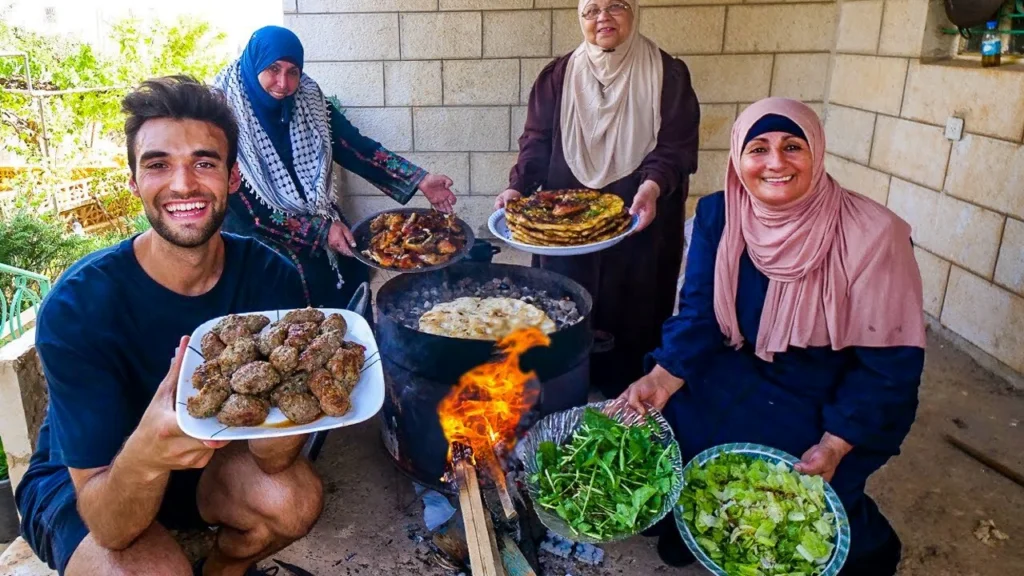
One cannot delve into Palestinian culinary traditions without mentioning maqluba, a dish as theatrical as it is tasty. Translating to “upside-down,” it’s a layered preparation of rice, vegetables, and meat or chicken. Once cooked, it’s flipped over to reveal a delectable mound of flavors.
Stews, often slow-cooked to perfection, are a staple. Okra, beans, or lentils simmered with tomatoes, garlic, and a medley of spices form the heart of many Palestinian meals. These stews are lovingly mopped up with bread, a testament to the cuisine’s communal essence.
For those with a sweet tooth, Palestinian desserts do not disappoint. Knafeh, with its luscious layers of cheese and shredded pastry soaked in syrup, is a crowd-pleaser. During festive occasions, ma’amoul cookies filled with dates or nuts grace many a table.
At its core, Palestinian culinary traditions are about more than just food. They represent stories of harvests and seasons, of family gatherings and ancient rituals. They are a reflection of the land’s generosity, the people’s tenacity, and an enduring spirit that finds comfort and identity in every shared meal.
Palestinian National Dish

The Palestinian national dish is widely considered to be Mansaf. Mansaf is a traditional Jordanian and Palestinian dish that holds cultural significance in the region. While it is also popular in Jordan, it is often regarded as a symbol of Palestinian hospitality and heritage.
Mansaf is a hearty dish typically made with lamb, rice, and a fermented dried yogurt known as jameed. The dish is often cooked for special occasions, celebrations, and family gatherings. The preparation involves slow-cooking pieces of lamb in jameed and a blend of aromatic spices until the meat becomes tender and flavorful.
The lamb and yogurt mixture is then served on a bed of fragrant rice, usually accompanied by a garnish of pine nuts and almonds. Mansaf is often enjoyed communally, with family members and guests sharing from the same large platter. This communal style of dining reflects the importance of hospitality and unity in Palestinian culture.
The Most Popular Palestinian Food
Palestinian cuisine is rich and diverse, reflecting the cultural heritage of the region. Here are some of the most popular Palestinian foods:
Hummus
- A creamy dip made from blended chickpeas, tahini, lemon juice, and garlic. It is often garnished with olive oil and served with pita bread.
Falafel
- Deep-fried balls or patties made from ground chickpeas or fava beans, mixed with herbs and spices. They are typically served in pita bread with tahini sauce.
Mansaf
- Considered the national dish, Mansaf is a festive and elaborate dish featuring lamb cooked in jameed (fermented dried yogurt), served with rice and garnished with nuts.
Musakhan
- A traditional dish consisting of roasted chicken seasoned with sumac, allspice, and onions, served on flatbread. It’s a flavorful and aromatic dish.
Maqluba
- A one-pot dish where rice, meat (often chicken or lamb), and vegetables are layered and cooked together. The dish is inverted before serving, creating a beautiful presentation.
Knafeh
- A popular dessert made with shredded phyllo dough layered with sweet cheese or semolina, baked until golden, and soaked in sugar syrup.
Tabbouleh
- A refreshing salad made with finely chopped parsley, tomatoes, mint, onions, and bulgur, dressed with olive oil and lemon juice.
Labneh
- A strained yogurt cheese that is thick and creamy, often served as a dip or spread. It can be topped with olive oil, herbs, or spices.
Ka’ak
- A type of bread, often in the form of a ring, sesame-covered ka’ak is a popular snack or breakfast item.
Stuffed Grape Leaves (Warak Enab)
- Grape leaves filled with a mixture of rice, pine nuts, and spices. They are typically served cold and make for a delicious appetizer.
Olive Oil
- Palestinian cuisine heavily relies on high-quality olive oil, which is used in various dishes and salads, enhancing flavors and nutritional value.
Palestinian food is not only delicious but also reflects the deep-rooted cultural and historical ties of the region. The use of fresh ingredients, herbs, and spices contributes to the distinctive and vibrant flavors of Palestinian cuisine.
How Healthy is Palestinian Food?
Palestinian food can be healthy or unhealthy, depending on the ingredients, portions, and cooking methods. Some of the factors that affect the healthiness of Palestinian food are:
Palestinian Food is high in Calories:
Palestinian food can be high in calories, especially when it involves fried foods, pastries, cheese, or meat. For example, a serving of kanafa (a cheese pastry with syrup) can have about 500 calories, while a serving of maqluba (a rice dish with meat and vegetables) can have about 600 calories.
To reduce calories, it is advisable to limit the intake of these foods, and opt for more grilled, baked, or steamed dishes, such as fish, chicken, or vegetables.
High Fat Content
Palestinian food can also be high in fat, especially saturated and trans fats, which can raise cholesterol levels and increase the risk of heart disease and stroke. These fats are found in butter, ghee, cheese, meat, and some oils.
For example, a serving of hummus (a chickpea dip) can have about 15 grams of fat, while a serving of shawarma (a meat sandwich) can have about 20 grams of fat.
To reduce fat, it is advisable to choose lean cuts of meat, remove the skin from poultry, use low-fat dairy products, and replace butter and ghee with olive oil, which is rich in monounsaturated fats that can lower cholesterol and protect the heart.
Palestinian Food is high in Fiber
Palestinian food can be a good source of fiber, which can help digestion, lower blood sugar and cholesterol levels, and prevent constipation and colon cancer. Fiber is found in whole grains, fruits, vegetables, legumes, and nuts.
For example, a serving of tabbouleh (a salad of bulgur, parsley, tomatoes, and mint) can have about 4 grams of fiber, while a serving of ful (a fava bean dip) can have about 8 grams of fiber. To increase fiber, it is advisable to eat more of these foods, and choose whole wheat bread over white bread, brown rice over white rice, and fresh fruits over dried fruits.
Palestinian Food is a Source of Vitamins and Minerals
Palestinian food can also provide various vitamins and minerals that are essential for the body’s functions and immunity. These include vitamin C, vitamin A, vitamin K, folate, iron, calcium, potassium, and magnesium. These nutrients are found in citrus fruits, leafy greens, tomatoes, peppers, carrots, dates, figs, olives, cheese, yogurt, and sesame seeds.
For example, a serving of molokhia (a soup of jute leaves and chicken) can provide about 60% of the daily value of vitamin A, while a serving of labneh (a strained yogurt) can provide about 30% of the daily value of calcium. To get enough vitamins and minerals, it is advisable to eat a variety of these foods, and avoid overcooking them, as this can reduce their nutritional value,
References
Traditional Palestinian Food
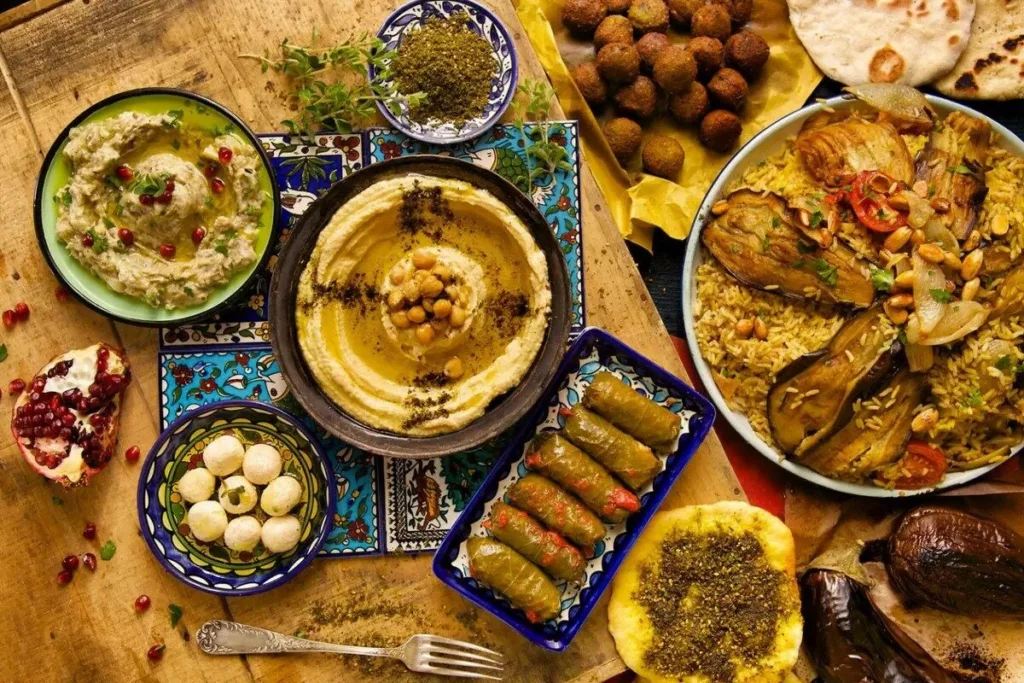
Traditional Palestinian food is known for its rich flavors and unique combinations of ingredients. It reflects the cultural diversity and history of the region.
From mouthwatering dishes like musakhan, a roasted chicken seasoned with sumac and served on a bed of sautéed onions and flatbread, to the fragrant maqluba, a layered dish of rice, vegetables, and meat, traditional Palestinian food offers a delightful and authentic gastronomic experience.
The use of aromatic spices, such as cumin, cardamom, and za’atar, adds a distinct and tantalizing taste to these dishes.
Whether enjoying a hearty meal in a local restaurant or savoring homemade delicacies, traditional Palestinian food is sure to satisfy the palate and leave a lasting impression.
Palestinian Cuisine – Great recipes to try at Home
The very essence of Palestinian cuisine lies in the heart of its taste. It’s more than just food; it’s an embodiment of Palestinian history, love, and resilience. From the aromatic spices to the fresh produce and hearty grains, every dish tells a story.
Palestinian Food – Falafel (Deep-fried balls or patties)

Exploring Palestinian Flavors: The History of Falafel
Welcome back to my stay-at-home kitchen, where we dive into the vibrant world of Palestinian cuisine. Today, we’re exploring the beloved street food staple – Falafel. Originating from the Middle East, falafel has deep roots in Palestinian culinary history.
These flavorful deep-fried balls or patties, typically made from chickpeas or fava beans, showcase the region’s rich tradition of using herbs and spices to create a mouthwatering delight. So, let’s embark on this culinary journey and bring the essence of Palestinian street food to your home!
Palestinian Food – Ingredients for Palestinian Falafel
- 2 cups dried chickpeas, soaked overnight
- 1 small onion, roughly chopped
- 3 cloves garlic
- 1 cup fresh parsley, chopped
- 1 teaspoon ground cumin
- 1 teaspoon ground coriander
- 1/2 teaspoon baking soda
- Salt and pepper to taste
- Vegetable oil for frying
Palestinian Food – Recipe for Palestinian Falafel
1. Prepare Chickpeas:
- Rinse and drain the soaked chickpeas. Pat them dry with a kitchen towel.
2. Blend Ingredients:
- In a food processor, combine chickpeas, chopped onion, garlic, fresh parsley, cumin, coriander, baking soda, salt, and pepper.
- Blend until the mixture forms a coarse paste. Avoid over-blending; a slightly chunky texture is ideal.
3. Shape Falafel:
- Scoop tablespoons of the mixture and shape them into small patties or balls. Place them on a tray lined with parchment paper.
4. Heat Oil:
- In a deep pan, heat vegetable oil over medium heat to 350°F (180°C).
5. Fry Falafel:
- Carefully place the shaped falafel into the hot oil, frying in batches for 3-4 minutes or until golden brown and crispy.
- Use a slotted spoon to transfer the falafel onto a paper towel-lined plate to absorb excess oil.
6. Serve and Enjoy:
- Serve your freshly fried falafel in pita bread or on a platter with tahini sauce, fresh veggies, and pickles.
Serving Information:
- Serves: 4 people
- Cooking Time: Approximately 30 minutes
- Calories: Each falafel ball is around 60 calories. The tahini sauce and accompaniments will add additional calories, so customize your toppings according to your preferences.
There you have it – a taste of Palestinian street food right from your kitchen. Enjoy the crispy exterior and flavorful interior of these falafel delights, and share the love of Middle Eastern cuisine with your family and friends!
Palestinian Food – Labneh (A strained yogurt cheese)

Unveiling Palestinian Delight: The Rich History of Labneh
Greetings from my kitchen to yours! Today, we’re diving into the world of Palestinian cuisine with a delightful treat – Labneh. Originating from the Middle East, Labneh is a versatile strained yogurt cheese that has been a staple in Palestinian households for generations.
This creamy delight is not just a spread or dip; it’s a reflection of the region’s rich dairy traditions and the art of transforming simple ingredients into something extraordinary. Let’s embark on this journey together and whip up a batch of homemade Labneh to savor those authentic Palestinian flavors!
Palestinian Food – Ingredients for Palestinian Labneh
- 4 cups full-fat Greek yogurt
- 1 teaspoon salt
- Olive oil (for serving)
- Fresh herbs (such as mint or thyme, optional)
- Za’atar spice blend (optional)
Palestinian Food – Recipe for Palestinian Labneh
1. Strain Yogurt:
- In a large bowl, mix Greek yogurt and salt until well combined.
- Line a fine-mesh sieve with cheesecloth and place it over a deep bowl. Pour the yogurt mixture into the sieve.
2. Set and Drain:
- Cover the yogurt with the excess cheesecloth. Allow it to strain in the refrigerator for 24-48 hours, depending on your desired thickness.
3. Shape Labneh:
- Once strained, transfer the thickened Labneh into a bowl. You can shape it into small balls or leave it in a spreadable consistency.
4. Serve and Garnish:
- Drizzle olive oil over the Labneh for a rich flavor and creamy texture.
- Optional: Sprinkle with fresh herbs like mint or thyme, or a pinch of Za’atar spice blend for an extra layer of flavor.
5. Enjoy!
- Serve your homemade Labneh with warm pita bread, veggies, or as a spread on crackers. Get creative with your toppings!
Serving Information:
- Serves: 6 people
- Cooking Time: 24-48 hours (straining time)
- Calories: Approximately 100 calories per 2-tablespoon serving. Nutritional values may vary based on the brand of yogurt used.
There you have it – a taste of Palestine right in your own kitchen! Enjoy the velvety smoothness of homemade Labneh and savor the authentic flavors that have been cherished for generations. Happy cooking!
Palestinian Food – Ka’ak (A type of bread)

Journey into Palestinian Culture: The History of Ka’ak
Welcome to my cozy kitchen! Today, we’re taking a delightful trip to the heart of Palestinian cuisine with a recipe that holds centuries of tradition – Ka’ak. Originating from the Middle East, Ka’ak is a unique type of bread that has been a cherished part of Palestinian culture.
Often shaped like a ring, this bread is not just a staple; it’s a symbol of communal gatherings and shared meals in Palestinian households. Let’s uncover the secrets of Ka’ak and bring the warmth of Palestinian baking to your home!
Palestinian Food – Ingredients for Palestinian Ka’ak
- 4 cups all-purpose flour
- 1 tablespoon sugar
- 1 teaspoon salt
- 1 tablespoon sesame seeds (optional for topping)
- 1 cup warm water
- 2 tablespoons olive oil
- 1 tablespoon active dry yeast
- 1 egg (for egg wash)
Palestinian Food – Recipe for Palestinian Ka’ak
1. Activate Yeast:
- In a bowl, combine warm water, sugar, and yeast. Let it sit for about 5 minutes until the yeast activates and becomes frothy.
2. Mix Dry Ingredients:
- In a large mixing bowl, combine flour and salt. Make a well in the center.
3. Combine Ingredients:
- Pour the activated yeast mixture into the well, add olive oil, and gradually mix the ingredients until a dough forms.
4. Knead Dough:
- Transfer the dough onto a floured surface and knead for about 10 minutes until it becomes smooth and elastic.
5. Let it Rise:
- Place the dough in a lightly oiled bowl, cover it with a damp cloth, and let it rise in a warm place for 1-2 hours, or until doubled in size.
6. Shape Ka’ak:
- Preheat your oven to 375°F (190°C).
- Divide the dough into small balls and roll each ball into a long rope. Shape the ropes into rings, pressing the ends together to secure.
7. Egg Wash and Sesame Topping:
- Whisk an egg and brush it over the shaped Ka’ak for a golden finish.
- Optional: Sprinkle sesame seeds on top.
8. Bake:
- Place the shaped Ka’ak on a baking sheet and bake for 15-20 minutes or until they turn golden brown.
9. Serve Warm:
- Allow the Ka’ak to cool slightly before serving. Enjoy it warm with your favorite spreads or dips!
Serving Information:
- Serves: 8 people
- Cooking Time: Approximately 2 hours (including rising time)
- Calories: Approximately 180 calories per serving (based on 1 Ka’ak).
There you have it – the wonderful aroma of freshly baked Ka’ak filling your kitchen! Enjoy this taste of Palestinian tradition and share the joy of breaking bread with your loved ones. Happy baking!
Palestinian Food – Stuffed Grape Leaves (Warak Enab)

Unveiling the Culinary Heritage: Stuffed Grape Leaves (Warak Enab) in Palestinian Cuisine
Welcome back to my kitchen, where we embark on a flavorful journey into the heart of Palestinian cuisine. Today, we’re diving into the time-honored tradition of making Stuffed Grape Leaves, known as Warak Enab.
Hailing from the Middle East, this dish reflects the rich history and cultural tapestry of Palestinian cooking. Stuffed with a tantalizing mixture of rice, pine nuts, and spices, these grape leaves are a delightful representation of the region’s culinary craftsmanship.
Let’s roll up our sleeves and create a taste of Palestine in the comfort of your home!
Palestinian Food – Ingredients for Palestinian Stuffed Grape Leaves
- 1 cup grape leaves (preserved in brine, drained and rinsed)
- 1 cup short-grain rice
- 1/2 cup pine nuts
- 1 medium onion, finely chopped
- 1/4 cup fresh parsley, chopped
- 2 tablespoons olive oil
- 1 tablespoon tomato paste
- 1 teaspoon ground allspice
- 1/2 teaspoon ground cinnamon
- Salt and pepper to taste
- Lemon wedges for serving
Palestinian Food – Recipe for Palestinian Stuffed Grape Leaves
1. Prepare Grape Leaves:
- Carefully separate grape leaves and blanch them in boiling water for 2-3 minutes. Drain and set aside.
2. Prepare Filling:
- In a pan, sauté chopped onions in olive oil until translucent.
- Add pine nuts and continue to sauté until golden brown.
- Stir in rice, tomato paste, parsley, allspice, cinnamon, salt, and pepper. Cook for an additional 2 minutes.
3. Assemble Stuffed Grape Leaves:
- Place a grape leaf on a flat surface, shiny side down. Trim the stem.
- Spoon a small amount of the rice mixture onto the center of the leaf.
- Fold the sides of the leaf over the filling and roll tightly.
4. Cook Stuffed Grape Leaves:
- Arrange the stuffed grape leaves in a pot, seam side down, creating layers.
- Add water to cover the grape leaves, place a plate on top to keep them secure, and simmer for 30-40 minutes.
5. Serve and Enjoy:
- Once cooked, let the grape leaves cool slightly before serving.
- Serve with lemon wedges for that extra burst of flavor.
Serving Information:
- Serves: 4 people
- Cooking Time: Approximately 1 hour
- Calories: Approximately 200 calories per serving (based on 4 stuffed grape leaves).
There you have it – the taste of Palestinian heritage wrapped in these Stuffed Grape Leaves. Enjoy the blend of spices and textures and savor the essence of Palestinian culinary tradition. Happy cooking!
Palestinian Food – Cauliflower Fritters (Emshat)

A Culinary Adventure: The Origin of Cauliflower Fritters (Emshat) in Palestinian Culture
Step into my kitchen for a taste of Palestinian cuisine with a modern twist – Cauliflower Fritters, locally known as Emshat. Originating from the Middle East, this dish reflects the creativity and adaptability within Palestinian cooking.
With a blend of spices and the wholesome goodness of cauliflower, Emshat brings a delightful crunch to your table. Join me on this culinary journey as we recreate a bit of Palestine right in your home!
Palestinian Food – Ingredients for Palestinian Cauliflower Fritters
- 1 medium cauliflower, cut into florets
- 1 cup chickpea flour
- 1/2 cup all-purpose flour
- 1 teaspoon baking powder
- 1 teaspoon ground cumin
- 1 teaspoon ground coriander
- 1/2 teaspoon turmeric
- 1/2 teaspoon paprika
- 1/2 teaspoon garlic powder
- 1/2 teaspoon onion powder
- Salt and pepper to taste
- 1/2 cup chopped fresh parsley
- 1/2 cup water (adjust as needed)
- Vegetable oil for frying
Palestinian Food – Recipe for Palestinian Cauliflower Fritters
1. Prepare Cauliflower:
- Steam or boil cauliflower florets until tender. Mash them or pulse in a food processor until a coarse texture is achieved.
2. Create Batter:
- In a large bowl, combine chickpea flour, all-purpose flour, baking powder, ground cumin, ground coriander, turmeric, paprika, garlic powder, onion powder, salt, and pepper.
3. Mix Ingredients:
- Add mashed cauliflower and chopped parsley to the dry ingredients. Gradually add water to create a thick batter.
4. Shape and Fry:
- Heat vegetable oil in a pan over medium heat.
- Spoon portions of the batter into the hot oil, shaping them into fritters. Fry until golden brown on both sides.
5. Drain and Serve:
- Place the cooked fritters on a paper towel to absorb excess oil.
- Serve hot, either as a snack or a side dish.
Serving Information:
- Serves: 4 people
- Cooking Time: Approximately 30 minutes
- Calories: Approximately 150 calories per 3 fritters (caloric content may vary based on oil absorption).
Experience the vibrant flavors of Palestine with these Cauliflower Fritters. Enjoy the crispy exterior and the savory goodness within. These Emshat are perfect for sharing with friends and family. Happy cooking!
Palestinian Food – Tatbeeleh (Shatta) (Spicy Salsa)

Savor the Spice: Unveiling the Origins of Tatbeeleh (Shatta) in Palestinian Tradition
Join me in the kitchen for a flavor-packed journey into the heart of Palestinian cuisine with Tatbeeleh, also known as Shatta – a spicy salsa that adds a kick to any dish. Originating from the Middle East, this fiery condiment is a culinary gem, showcasing the bold and vibrant flavors of the region.
Let’s explore the history and craft a homemade version of Tatbeeleh to elevate your meals with a burst of Palestinian spice!
Palestinian Food – Ingredients for Palestinian Tatbeeleh (Shatta)
- 4-5 hot red chili peppers, stemmed and chopped
- 2-3 cloves garlic, minced
- 1 teaspoon ground cumin
- 1 teaspoon ground coriander
- 1 teaspoon salt
- 1/2 cup fresh cilantro, chopped
- 1/4 cup fresh parsley, chopped
- 2 tablespoons olive oil
- 1 tablespoon lemon juice
Palestinian Food – Recipe for Palestinian Tatbeeleh (Shatta)
1. Prep Peppers:
- Wear gloves to handle hot peppers.
- Remove stems and chop the peppers into smaller pieces.
2. Blend Ingredients:
- In a blender or food processor, combine chopped chili peppers, minced garlic, ground cumin, ground coriander, and salt.
- Blend until you achieve a coarse paste.
3. Add Fresh Herbs:
- Add chopped cilantro and parsley to the pepper mixture in the blender.
- Blend briefly until the herbs are finely chopped and incorporated.
4. Finish with Olive Oil and Lemon Juice:
- While the blender is running, stream in olive oil and lemon juice.
- Blend until the Tatbeeleh reaches your desired consistency.
5. Adjust Seasoning:
- Taste and adjust salt or lemon juice as needed.
- Transfer the spicy salsa to a jar or container.
Serving Information:
- Serves: 8 people
- Preparation Time: 15 minutes
- Calories: Approximately 20 calories per tablespoon (caloric content may vary based on specific ingredients).
There you have it – a jar of homemade Palestinian Tatbeeleh to spice up your dishes! This versatile salsa pairs perfectly with grilled meats, falafel, or as a condiment to add a bold punch to your meals. Enjoy the fiery kick of Palestinian flavor!
Palestinian Food – Sheikh Makhshi (Kusa Bi Laban)

Culinary Traditions Unveiled: The Story Behind Sheikh Makhshi (Kusa Bi Laban)
Step into my kitchen for a delightful exploration of Palestinian cuisine with Sheikh Makhshi, also known as Kusa Bi Laban – a dish rooted in the region’s rich culinary history.
Originating from the Middle East, this comforting dish showcases the art of combining zucchini, yogurt, and flavorful spices.
Join me on this culinary journey as we uncover the origins of Sheikh Makhshi and create a taste of Palestinian tradition right at home!
Palestinian Food – Ingredients for Palestinian Sheikh Makhshi (Kusa Bi Laban)
- 4 medium-sized zucchini
- 2 cups plain yogurt
- 2 tablespoons olive oil
- 3 cloves garlic, minced
- 1 teaspoon ground coriander
- 1 teaspoon ground cumin
- 1 teaspoon paprika
- Salt and pepper to taste
- 1 tablespoon fresh mint, chopped (optional for garnish)
Palestinian Food – Recipe for Palestinian Sheikh Makhshi (Kusa Bi Laban)
1. Prepare Zucchini:
- Wash and peel the zucchini. Cut them in half lengthwise and scoop out the seeds, creating a hollow center.
2. Steam Zucchini:
- Steam the hollowed zucchini halves for approximately 10 minutes until they are slightly tender but still firm.
3. Prepare Yogurt Mixture:
- In a bowl, whisk together yogurt, minced garlic, ground coriander, ground cumin, paprika, salt, and pepper.
4. Fill Zucchini:
- Carefully fill each steamed zucchini half with the yogurt mixture.
5. Cook Zucchini in Olive Oil:
- Heat olive oil in a pan over medium heat. Place the filled zucchini halves in the pan, cover, and cook for about 15-20 minutes or until the zucchini is fully cooked.
6. Garnish and Serve:
- Optional: Garnish with chopped fresh mint for a burst of flavor.
- Serve Sheikh Makhshi warm, either as a side dish or a light main course.
Serving Information:
- Serves: 4 people
- Cooking Time: Approximately 30 minutes
- Calories: Approximately 120 calories per serving (caloric content may vary based on specific ingredients).
There you have it – a plate of Sheikh Makhshi, a dish that brings the essence of Palestinian flavors to your table. Enjoy the creamy texture of yogurt combined with the earthy taste of zucchini, creating a harmony that defines Palestinian comfort food. Happy cooking!
Palestinian Food – Chicken Fatteh

A Taste of Tradition: Unraveling the Story Behind Palestinian Chicken Fatteh
Welcome back to my kitchen! Today, we’re diving into the heart of Palestinian cuisine with a dish that encapsulates the essence of the region – Chicken Fatteh. Originating from the Middle East, this flavorful dish boasts a history rich in culinary traditions.
It’s a symphony of textures and tastes, combining tender chicken, crispy bread, and creamy yogurt. Join me in recreating the warmth of Palestinian kitchens as we prepare Chicken Fatteh from scratch!
Palestinian Food – Ingredients for Palestinian Chicken Fatteh
- 1 whole chicken, cut into pieces
- 4 cups plain yogurt
- 4 cloves garlic, minced
- 1 teaspoon ground cumin
- 1 teaspoon ground coriander
- Salt and pepper to taste
- 4 pita bread rounds, toasted and broken into pieces
- 1/4 cup pine nuts, toasted
- 2 tablespoons olive oil
- Chopped fresh parsley for garnish
Palestinian Food – Recipe for Palestinian Chicken Fatteh
1. Prepare the Chicken:
- Season chicken pieces with salt, pepper, ground cumin, and ground coriander.
- In a large pot, cook the chicken until fully cooked and tender. Once done, shred the chicken into bite-sized pieces.
2. Make Yogurt Sauce:
- In a bowl, mix plain yogurt, minced garlic, salt, and pepper. Adjust seasoning to taste.
3. Toast Pita Bread:
- Toast pita bread rounds until crispy. Break them into bite-sized pieces.
4. Assemble Chicken Fatteh:
- In a serving dish, layer the toasted pita bread pieces.
- Spread a generous layer of the yogurt sauce over the bread.
- Add the shredded chicken on top of the yogurt.
5. Drizzle Olive Oil and Garnish:
- Drizzle olive oil over the Chicken Fatteh.
- Sprinkle toasted pine nuts and chopped fresh parsley as a finishing touch.
6. Serve Warm:
- Serve Chicken Fatteh warm, allowing the layers to meld and create a delicious harmony of flavors.
Serving Information:
- Serves: 6 people
- Cooking Time: Approximately 1 hour
- Calories: Approximately 350 calories per serving (caloric content may vary based on specific ingredients).
There you have it – a plate of Chicken Fatteh, a dish that encapsulates the heart and soul of Palestinian cuisine. Enjoy the layers of taste and textures that make this meal a true celebration of flavors. Happy cooking!
Palestinian Food – Rashta (Irkak o Adas)

Delving into Tradition: The Origins of Palestinian Rashta (Irkak o Adas)
Welcome to my kitchen, where we embark on a culinary journey to explore the flavors of Palestinian cuisine with a dish known as Rashta, featuring the wholesome combination of Irkak (vine leaves) and Adas (lentils).
Originating from the Middle East, Rashta is a delightful stew that showcases the region’s love for hearty and nutritious meals. Let’s uncover the history behind this dish and create a taste of Palestinian warmth in your own home!
Palestinian Food – Ingredients for Palestinian Rashta (Irkak o Adas)
- 1 cup dried green or brown lentils, rinsed
- 1 cup rice
- 1 cup chopped vine leaves (fresh or preserved in brine)
- 1 large onion, finely chopped
- 2 cloves garlic, minced
- 2 tablespoons olive oil
- 1 teaspoon ground cumin
- 1 teaspoon ground coriander
- 1 teaspoon ground turmeric
- Salt and pepper to taste
- 6 cups vegetable or chicken broth
- Fresh lemon wedges for serving
Palestinian Food – Recipe for Palestinian Rashta (Irkak o Adas)
1. Prepare Lentils and Rice:
- In a pot, combine rinsed lentils and rice with 4 cups of broth.
- Bring to a boil, then reduce heat, cover, and simmer for 20-25 minutes until lentils and rice are tender.
2. Sauté Onion and Garlic:
- In a separate pan, heat olive oil over medium heat.
- Sauté chopped onion and minced garlic until golden brown.
3. Add Vine Leaves and Spices:
- Add chopped vine leaves to the onion-garlic mixture and sauté for an additional 5 minutes.
- Stir in ground cumin, ground coriander, ground turmeric, salt, and pepper.
4. Combine Ingredients:
- Mix the sautéed vine leaves with the cooked lentils and rice.
5. Simmer Rashta:
- Add the remaining 2 cups of broth to the mixture and simmer for an additional 10-15 minutes, allowing the flavors to meld.
6. Serve with Lemon Wedges:
- Ladle Rashta into bowls and serve with fresh lemon wedges for a burst of citrusy flavor.
Serving Information:
- Serves: 4 people
- Cooking Time: Approximately 45 minutes
- Calories: Approximately 300 calories per serving (caloric content may vary based on specific ingredients).
There you have it – a bowl of Rashta, a comforting and nutritious stew that captures the essence of Palestinian home-cooked meals. Enjoy the blend of lentils, rice, and vine leaves that make this dish a true celebration of Middle Eastern flavors. Happy cooking!
Palestinian Food – Purslane Stew Recipe

Embracing Tradition: The Roots of Palestinian Purslane Stew
In our culinary exploration, we’re diving into the heart of Palestinian heritage with a dish that captures the essence of the region – Purslane Stew. Known for its rich flavors and nutritional value, this stew is a celebration of locally sourced ingredients and time-honored cooking techniques.
Join me as we uncover the history behind this dish and recreate a taste of Palestine in your own kitchen!
Palestinian Food – Ingredients for Palestinian Purslane Stew
- 2 cups fresh purslane, cleaned and chopped
- 1 cup diced tomatoes
- 1 cup chickpeas, cooked
- 1 large onion, finely chopped
- 2 cloves garlic, minced
- 2 tablespoons olive oil
- 1 teaspoon ground coriander
- 1 teaspoon ground cumin
- 1 teaspoon paprika
- Salt and pepper to taste
- 4 cups vegetable or chicken broth
- Lemon wedges for serving
Palestinian Food – Recipe for Palestinian Purslane Stew
1. Clean and Prepare Purslane:
- Wash fresh purslane thoroughly and chop it into bite-sized pieces.
2. Sauté Onion and Garlic:
- In a pot, heat olive oil over medium heat.
- Sauté chopped onion and minced garlic until softened and fragrant.
3. Add Tomatoes and Spices:
- Stir in diced tomatoes, ground coriander, ground cumin, paprika, salt, and pepper.
- Cook until the tomatoes are softened and the spices are well incorporated.
4. Incorporate Purslane and Chickpeas:
- Add the chopped purslane and cooked chickpeas to the pot, stirring to combine.
5. Pour in Broth:
- Pour in the vegetable or chicken broth, ensuring it covers the ingredients.
- Bring the stew to a gentle boil.
6. Simmer and Serve:
- Reduce the heat and let the stew simmer for 15-20 minutes, allowing the flavors to meld.
- Serve hot with lemon wedges for a tangy finish.
Serving Information:
- Serves: 4 people
- Cooking Time: Approximately 30 minutes
- Calories: Approximately 150 calories per serving (caloric content may vary based on specific ingredients).
There you have it – a bowl of Purslane Stew, a nourishing dish that echoes the culinary traditions of Palestine. Enjoy the vibrant flavors and health benefits of purslane in this comforting stew. Happy cooking!
Palestinian Food – Meat Stuffed Pitas (Palestinian Arayes)

Embracing Palestinian Flavors: Unveiling the Story of Meat Stuffed Pitas (Arayes)
Let’s embark on a culinary journey into the heart of Palestine with a dish that’s not just a meal but a celebration of tradition – Meat Stuffed Pitas, also known as Arayes. Originating from the Middle East, Arayes are a delightful fusion of minced meat, aromatic spices, and the comforting embrace of grilled pitas.
Join me as we explore the history behind this dish and create a taste of Palestinian warmth in your own kitchen!
Palestinian Food – Ingredients for Palestinian Meat Stuffed Pitas (Arayes)
- 1 pound ground lamb or beef
- 1 large onion, finely chopped
- 2 cloves garlic, minced
- 1 teaspoon ground cumin
- 1 teaspoon ground coriander
- 1 teaspoon paprika
- Salt and pepper to taste
- 1/4 cup fresh parsley, chopped
- 4 large pita bread rounds
- Olive oil for brushing
Palestinian Food – Recipe for Palestinian Meat Stuffed Pitas (Arayes)
1. Prepare the Meat Mixture:
- In a bowl, combine ground meat, chopped onion, minced garlic, ground cumin, ground coriander, paprika, salt, pepper, and chopped parsley.
- Mix the ingredients thoroughly to form a well-seasoned meat mixture.
2. Assemble the Arayes:
- Cut the pita bread rounds in half.
- Open each half to create a pocket.
- Stuff the pockets with the seasoned meat mixture, ensuring an even distribution.
3. Grill the Arayes:
- Preheat a grill or grill pan over medium heat.
- Brush the stuffed pitas with olive oil on both sides.
- Grill each side for approximately 5-7 minutes or until the meat is cooked through and the pitas are crispy.
4. Serve Warm:
- Once grilled, slice the Arayes into halves or quarters.
- Serve them warm as a delightful appetizer or a main dish.
Serving Information:
- Serves: 4 people
- Cooking Time: Approximately 20 minutes
- Calories: Approximately 300 calories per serving (caloric content may vary based on specific ingredients).
Enjoy the delightful flavors of Palestine with these Meat Stuffed Pitas. Whether you’re hosting a gathering or craving a comforting meal, Arayes is a versatile and delicious choice. Happy grilling!
Palestinian Food – Sfeeha Yafawiyeh (Spiral Meat Pies)

Embracing Palestinian Heritage: The Tale of Sfeeha Yafawiyeh (Spiral Meat Pies)
Let’s embark on a delightful culinary journey to Palestine with a recipe that encapsulates the rich flavors and traditions of the region – Sfeeha Yafawiyeh, also known as Spiral Meat Pies.
Originating from the Middle East, these savory delights are a testament to Palestinian culinary artistry. Join me as we delve into the history behind this dish and create a taste of Palestinian warmth right in your own kitchen!
Palestinian Food – Ingredients for Palestinian Sfeeha Yafawiyeh (Spiral Meat Pies)
Dough:
- 3 cups all-purpose flour
- 1 tablespoon active dry yeast
- 1 teaspoon sugar
- 1 cup warm water
- 1/4 cup olive oil
- 1 teaspoon salt
Meat Filling:
- 1 pound ground lamb or beef
- 1 large onion, finely chopped
- 2 tablespoons pine nuts (optional)
- 2 tablespoons pomegranate molasses
- 1 teaspoon ground cinnamon
- 1 teaspoon ground allspice
- Salt and pepper to taste
Recipe for Palestinian Sfeeha Yafawiyeh (Spiral Meat Pies):
1. Prepare the Dough:
- In a bowl, dissolve sugar in warm water and add yeast. Let it sit for 5 minutes until frothy.
- In a large mixing bowl, combine flour and salt. Make a well in the center and pour in the yeast mixture and olive oil.
- Knead the dough until smooth, cover, and let it rise for about 1 hour or until doubled in size.
2. Make the Meat Filling:
- In a skillet over medium heat, cook ground meat until browned.
- Add chopped onions, pine nuts (if using), pomegranate molasses, ground cinnamon, ground allspice, salt, and pepper.
- Cook until onions are soft and flavors are well combined.
3. Assemble the Spiral Pies:
- Preheat the oven to 375°F (190°C).
- Divide the dough into golf ball-sized portions and roll each into a thin circle.
- Place a spoonful of the meat filling in the center of each circle.
- Fold the edges of the circle over the filling to create a spiral pattern, leaving the center open.
4. Bake the Sfeeha Yafawiyeh:
- Place the assembled pies on a baking sheet.
- Bake for 15-20 minutes or until the dough is golden brown and the meat filling is cooked through.
5. Serve Warm:
- Allow the Spiral Meat Pies to cool slightly before serving.
- Enjoy these delicious Sfeeha Yafawiyeh warm, either as an appetizer or a satisfying snack.
Serving Information:
- Serves: 6 people
- Cooking Time: Approximately 1 hour (including dough rising time)
- Calories: Approximately 250 calories per serving (caloric content may vary based on specific ingredients).
Immerse yourself in the authentic flavors of Palestine with these Sfeeha Yafawiyeh. Whether shared with family or friends, these spiral meat pies are a true delight. Happy baking!
Palestinian Food – Palestinian Makrouta

Rediscovering Tradition: The Heritage of Palestinian Makrouta
Join me on a culinary exploration as we dive into the heart of Palestinian culture with a recipe that has stood the test of time – Palestinian Makrouta. Originating from the Middle East,
Makrouta is a delectable dessert that reflects the richness of Palestinian heritage. Let’s uncover the history behind this sweet treat and create a taste of tradition in your own kitchen!
Palestinian Food – Ingredients for Palestinian Makrouta
- Dough:
- 2 cups semolina
- 1 cup all-purpose flour
- 1 cup clarified butter (ghee), melted
- 1/2 cup orange blossom water
- 1/2 cup water
- Date Filling:
- 2 cups dates, pitted and chopped
- 1 tablespoon clarified butter (ghee)
- 1/2 teaspoon ground cinnamon
- 1/4 teaspoon ground cloves
- Syrup:
- 1 cup sugar
- 1/2 cup water
- 1 tablespoon lemon juice
- 1 tablespoon orange blossom water
Palestinian Food – Recipe for Palestinian Makrouta
1. Prepare the Date Filling:
- In a pan, heat clarified butter and add chopped dates, ground cinnamon, and ground cloves.
- Cook the mixture over medium heat until the dates soften and the flavors meld.
- Remove from heat and let it cool.
2. Make the Dough:
- In a mixing bowl, combine semolina, all-purpose flour, melted clarified butter, and orange blossom water.
- Gradually add water while kneading until you achieve a soft, pliable dough.
3. Assemble the Makrouta:
- Divide the dough into walnut-sized portions and shape each into a small disc.
- Place a small amount of the date filling in the center of each disc.
- Enclose the filling and roll the dough into a cylindrical shape.
4. Bake the Makrouta:
- Preheat the oven to 350°F (175°C).
- Place the Makrouta on a baking sheet and bake for 20-25 minutes or until golden brown.
5. Prepare the Syrup:
- In a saucepan, combine sugar, water, and lemon juice.
- Bring to a boil, then reduce heat and simmer until the syrup thickens.
- Stir in orange blossom water and let it cool.
6. Soak in Syrup:
- Once the Makrouta is baked, immerse it in the cooled syrup for a few minutes, ensuring it absorbs the sweetness.
7. Serve and Enjoy:
- Allow the Makrouta to cool before serving.
- Enjoy this delightful Palestinian dessert with a cup of tea or coffee.
Serving Information:
- Serves: 8 people
- Cooking Time: Approximately 1 hour
- Calories: Approximately 300 calories per serving (caloric content may vary based on specific ingredients).
Indulge in the flavors of Palestinian Makrouta, a sweet homage to tradition that will transport you to the heart of Middle Eastern culinary heritage. Happy baking!
Palestinian Food – Hilbeh | Fenugreek Cake

Unveiling Tradition: Hilbeh, the Flavors of Palestine
Embark on a delightful journey into Palestinian culinary heritage with a recipe that encapsulates the essence of the region – Hilbeh, also known as Fenugreek Cake. Originating from the Middle East, this unique dessert boasts a rich history and a distinct combination of flavors.
Join me as we explore the roots of Hilbeh and recreate a piece of Palestinian culture in your own kitchen!
Palestinian Food – Ingredients for Palestinian Hilbeh
- Cake:
- 1 cup fenugreek seeds
- 2 cups water
- 1 cup semolina
- 1 cup sugar
- 1/2 cup vegetable oil
- 1 teaspoon baking powder
- 1/2 teaspoon baking soda
- 1/4 teaspoon salt
- Syrup:
- 1 cup sugar
- 1/2 cup water
- 1 tablespoon lemon juice
- 1 teaspoon orange blossom water (optional)
Palestinian Food – Recipe for Palestinian Hilbeh
1. Prepare Fenugreek Mixture:
- Soak fenugreek seeds in water for at least 8 hours or overnight.
- Blend soaked fenugreek seeds with water until you get a smooth mixture.
2. Make the Cake Batter:
- In a mixing bowl, combine fenugreek mixture, semolina, sugar, vegetable oil, baking powder, baking soda, and salt.
- Mix until well combined, creating a smooth batter.
3. Bake the Hilbeh:
- Preheat the oven to 350°F (175°C).
- Grease a baking dish and pour the cake batter into it.
- Bake for 30-35 minutes or until a toothpick inserted in the center comes out clean.
4. Prepare the Syrup:
- In a saucepan, combine sugar, water, and lemon juice for the syrup.
- Bring to a boil, then reduce heat and simmer until the syrup thickens.
- Stir in orange blossom water if using, and let it cool.
5. Soak the Cake:
- Once the Hilbeh is baked, let it cool for a few minutes.
- Pour the prepared syrup over the warm cake, ensuring it is evenly soaked.
6. Serve and Enjoy:
- Allow the Hilbeh to absorb the syrup before slicing.
- Serve this unique Fenugreek Cake as a sweet treat for family and friends.
Serving Information:
- Serves: 10 people
- Cooking Time: Approximately 1 hour (including soaking time)
- Calories: Approximately 250 calories per serving (caloric content may vary based on specific ingredients).
Experience the distinctive flavors of Palestine with Hilbeh, a dessert that brings together tradition and taste. Enjoy this Fenugreek Cake as a sweet finale to your Middle Eastern culinary adventure. Happy baking!
Palestinian Cuisine – Hummus
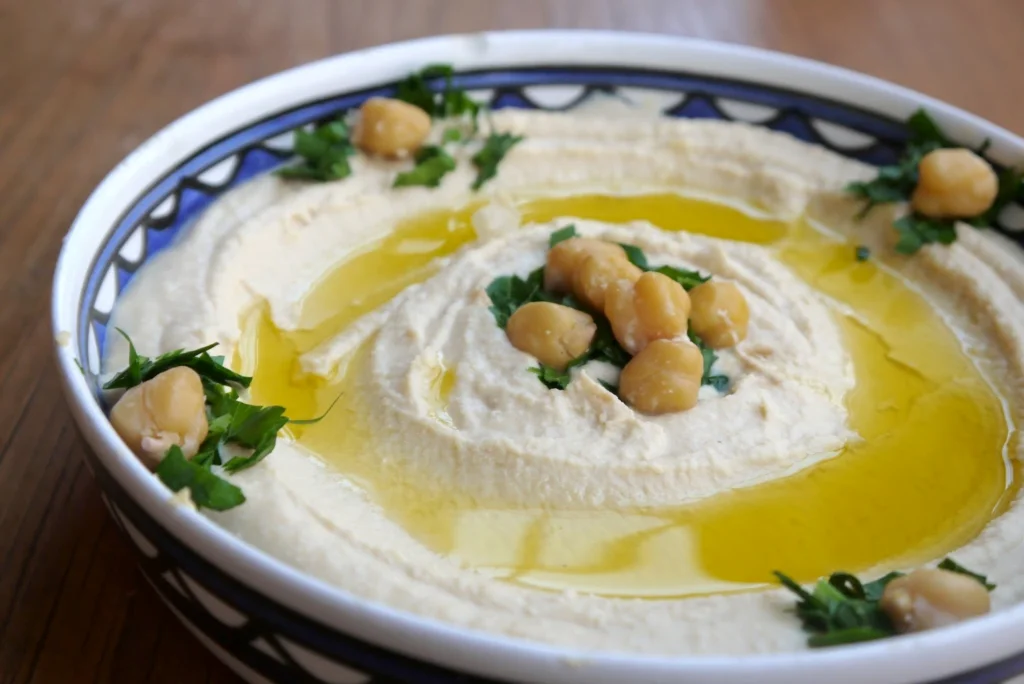
Hummus, the velvety and creamy chickpea spread, has been a staple in the Middle Eastern diet for centuries. Its name, derived from the Arabic word for chickpeas, reveals its essence. Historians believe hummus originated in ancient Egypt, but each country in the Middle East has its version, and Palestine is no exception.
Palestinian hummus stands out with its rich texture, simplicity, and the generous use of high-quality olive oil.
In Palestinian culture, hummus is more than just food; it represents warmth, hospitality, and tradition. Served for breakfast, lunch, or a snack, it’s a common sight in family gatherings and festive events. Often paired with freshly baked bread, it’s the ultimate comfort food for many.
Palestinian Cuisine – Ingredients for Hummus
- 2 cups of dried chickpeas (or 4 cups of canned chickpeas)
- 1/2 cup tahini (sesame seed paste)
- 3-4 cloves of garlic, minced
- Juice of 2 lemons (about 4-5 tablespoons)
- 1 teaspoon of salt, or to taste
- 1/2 teaspoon cumin (optional)
- 1/4 cup cold water (or as needed to achieve desired consistency)
- Extra virgin olive oil, for drizzling
- Paprika or sumac, for garnish
- Fresh parsley, finely chopped (for garnish)
- 2-3 ice cubes (helps in achieving a smoother texture)
How to prepare Hummus
Preparation of Dried Chickpeas (Skip this step if using canned chickpeas)
- Soak the dried chickpeas overnight in plenty of water with 1 teaspoon of baking soda.
- The next day, rinse and drain the chickpeas. Place them in a pot with fresh water and bring to a boil. Simmer for about 1-2 hours or until the chickpeas are tender and can be easily mashed.
- Drain the chickpeas, saving a cup of the cooking water.
- In a food processor or high-speed blender, combine the soft chickpeas (reserve a few for garnish), tahini, minced garlic, lemon juice, salt, and cumin if using. Blend until smooth.
- Add ice cubes to the mixture and blend again. Slowly incorporate cold water until you achieve your desired consistency. The mixture should be smooth and creamy.
- Taste and adjust seasonings. If more tanginess is desired, you can add extra lemon juice. Add more salt if needed.
- Transfer the hummus to a serving bowl. Using the back of a spoon, make a well in the center. Drizzle generously with olive oil.
- Garnish with reserved chickpeas, a sprinkle of paprika or sumac, and fresh parsley.
- Serve with warm pita bread, fresh vegetables, or as a spread in sandwiches.
Presentation and Serving
Hummus is traditionally presented in a shallow bowl with a well in the center filled with olive oil. The dish is garnished with whole chickpeas, a sprinkle of paprika or sumac for color, and sometimes chopped parsley for a touch of green.
Serving it with fresh out-of-the-oven pita bread elevates the experience, making each bite warm and comforting.
Perfect Drink Pairing
Minty lemonade or herbal tea, like mint or sage tea, complements the creaminess of hummus perfectly. These drinks offer a refreshing contrast and cleanse the palate, making every bite of hummus as delightful as the first.
Hummus, in its simplicity, carries the weight of centuries of tradition. It’s a dish that has traveled continents and bridged cultures but has always remained true to its roots. Whether you’re enjoying it in a Palestinian home, a bustling market in Jerusalem, or your own kitchen, you’re partaking in a ritual that celebrates community, hospitality, and the rich tapestry of Middle Eastern culture.
Palestinian Cuisine – Tabouleh
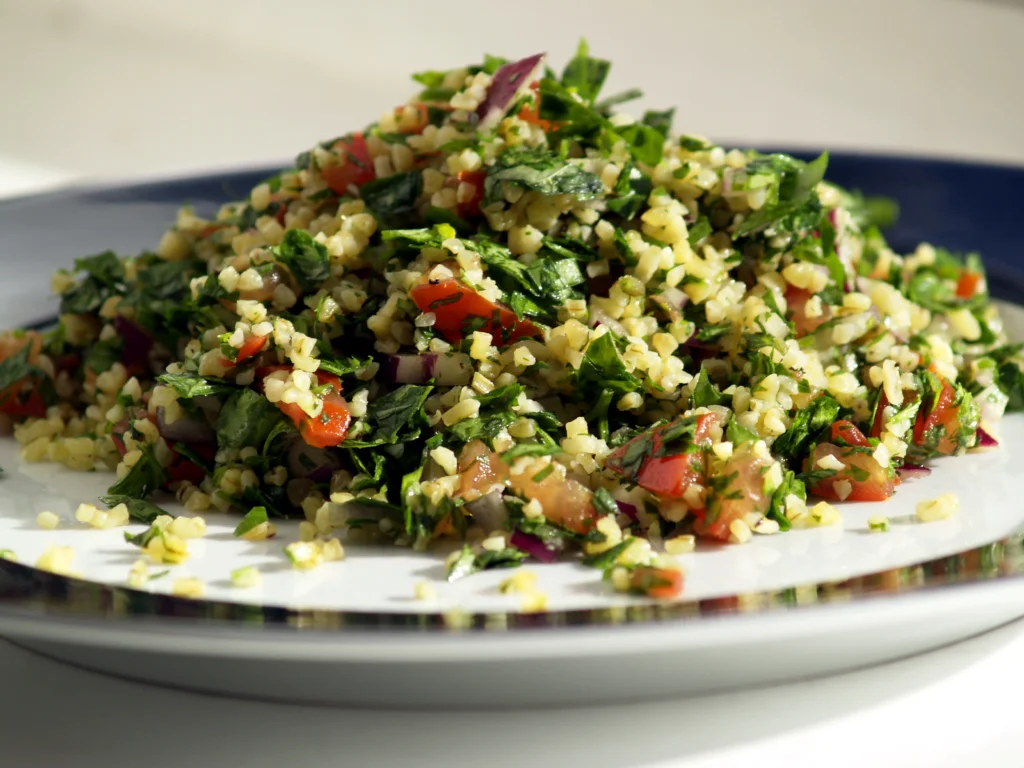
Tabouleh, a vibrant green parsley salad speckled with tomatoes, onions, and cracked wheat (bulgur), is one of the most iconic dishes of Palestinian and Levantine cuisine. Its roots trace back to the mountains of Lebanon and Syria, where it was a popular rural meal known for its refreshing taste and nutritional value.
Over time, Tabouleh found its way into the hearts and kitchens of neighboring countries, including Palestine, where it took on its unique characteristics.
In Palestinian tradition, Tabouleh is not just a side dish; it’s a celebration of the region’s agricultural bounty, especially during spring when fresh parsley is abundant. The dish signifies freshness, health, and the bond between the land and its people.
Palestinian Cuisine – Ingredients for Tabouleh
- 1 cup fresh flat-leaf parsley, finely chopped
- 1/4 cup fresh mint, finely chopped
- 1/4 cup fine bulgur wheat
- 2 large tomatoes, finely diced
- 1 small cucumber, finely diced (optional in traditional recipes but common in variations)
- 3 green onions (spring onions), finely sliced
- 3-4 tablespoons fresh lemon juice
- 3-4 tablespoons extra virgin olive oil
- Salt, to taste
- 1/4 teaspoon black pepper
- 1/4 teaspoon ground allspice (optional)
How to prepare Tabouleh
Bulgur Preparation
Place the bulgur in a bowl and cover it with cold water. Let it soak for about 20-30 minutes. The bulgur should soften but still have a slight bite. Once soaked, drain any excess water and press out any remaining moisture using a clean kitchen towel or paper towel.
In a large mixing bowl, combine the finely chopped parsley, mint, diced tomatoes, cucumber (if using), and sliced green onions.
Add the soaked and drained bulgur to the mixture.
In a separate small bowl or jar, whisk together lemon juice, olive oil, salt, black pepper, and allspice (if using) to create the dressing.
Pour the dressing over the salad ingredients and toss well to ensure everything is evenly coated.
Taste and adjust seasonings, if necessary. If you prefer a tangier flavor, feel free to add more lemon juice.
Let the Tabouleh sit for about 30 minutes before serving, allowing the flavors to meld.
Presentation and Serving
Traditionally, Tabouleh is served in a communal bowl and scooped up with romaine or lettuce leaves, which act as edible spoons.
Its vibrant green color contrasted with the red of tomatoes offers a visual feast. For individual servings, it can be served in small bowls or even in elegant glasses for a modern touch.
Perfect Drink Pairing
To complement the fresh and tangy flavors of Tabouleh, consider serving it with chilled white wine, especially those with citrus undertones, or with a cold minty lemonade.
These beverages balance the salad’s zesty character and enhance the overall dining experience.
Tabouleh embodies the essence of Palestinian agriculture, capturing the freshness of the fields in every bite. It’s a dish that speaks to the soul, evoking memories of family gatherings, bustling marketplaces, and the verdant landscapes of Palestine. Whether enjoyed on a hot summer day or as part of a grand feast, Tabouleh remains a testament to the rich culinary heritage and resilience of the Palestinian people.
Palestinian National Dish – Mansaf

History and Background
Mansaf is a traditional dish in Palestinian cuisine and is considered the national dish. It holds cultural and social significance, often served at special occasions and celebrations.
The word “mansaf” is derived from the term “safa,” which means “large tray” in Arabic. The dish is known for its unique preparation and the use of a fermented yogurt sauce called “jameed.”
Palestinian National Dish – Mansaf Ingredients
Lamb
- 1.5 to 2 kg lamb, cut into large pieces
- 2 large onions, finely chopped
- 3 tablespoons vegetable oil
- 2 teaspoons ground turmeric
- Salt and pepper to taste
- Water for boiling
Jameed Sauce
- 200g jameed (dried fermented yogurt)
- 2 liters water
- 2 tablespoons vegetable oil
Rice
- 2 cups basmati rice, washed and soaked
- 3 tablespoons ghee or clarified butter
- Salt to taste
Garnish
- Almonds or pine nuts, toasted
- Fresh parsley, chopped
Palestinian National Dish – Mansaf Instructions
Preparing the Lamb
- In a large pot, sauté the chopped onions in vegetable oil until golden brown.
- Add the lamb pieces, turmeric, salt, and pepper. Brown the meat on all sides.
- Cover the lamb with water, bring to a boil, then reduce heat and simmer until the meat is tender and cooked through. This can take a few hours, and you may need to add water as it simmers.
The Jameed Sauce
- Grate the jameed into a bowl, then gradually add water while stirring to create a smooth mixture.
- In a separate pot, heat vegetable oil, add the jameed mixture, and bring it to a gentle simmer. Stir continuously until it thickens. Be cautious not to let it boil over.
The Rice
- In a separate pot, bring water to a boil, add salt, and then add the soaked rice. Cook until the rice is almost done.
- Drain the rice and rinse it with cold water.
Assembling Mansaf
- On a large serving tray, spread a layer of flatbread or cooked rice.
- Place the cooked lamb on top of the bread or rice.
- Pour the jameed sauce over the lamb, covering it generously.
- Place the drained rice over the lamb and jameed mixture.
- Garnish with toasted almonds or pine nuts and chopped fresh parsley.
Mansaf is traditionally eaten communally, with diners using their right hand to scoop up portions of rice and lamb. It’s a symbol of hospitality and celebration in Palestinian and Jordanian cultures.
Palestinian Cuisine – Ancient Grain Maqluba

Ancient Grain Maqluba, which literally translates to “upside-down” in Arabic, is a traditional Palestinian one-pot dish known for its dramatic presentation and rich layering of flavors. As the name suggests, Maqluba is cooked in layers in a pot and then flipped over onto a plate for serving, revealing a delightful mosaic of rice, meat, and vegetables.
The origins of Ancient Grain Maqluba are somewhat debated, but it’s believed to date back to the 12th century. This dish’s beauty lies in its versatility, as it’s made across different regions of the Middle East with various ingredients. However, the Palestinian version often emphasizes using eggplants and cauliflower along with rice and meat.
Palestinian Cuisine – Ingredients for Ancient Grain Maqluba
- 2 cups of long-grain rice
- 1 lb (450 grams) of chicken or lamb, cut into pieces
- 2 medium eggplants, sliced
- 1 small cauliflower, broken into florets (optional)
- 3 cups of chicken or vegetable broth
- 1 large onion, finely chopped
- 4 cloves of garlic, minced
- 1/4 cup of olive oil
- 2 tsp of ground allspice
- 1 tsp of ground turmeric
- 1 tsp of ground cumin
- Salt and pepper to taste
- A handful of toasted pine nuts or slivered almonds for garnish
- Fresh parsley, chopped, for garnish
How to prepare Ancient Grain Maqluba
Preparing the Vegetables
- Begin by lightly salting the eggplant slices and placing them on paper towels for about 30 minutes. This helps draw out bitterness. Fry the eggplant slices and cauliflower florets in oil until golden brown, then set them aside on paper towels to drain excess oil.
- In a large pot, heat some olive oil and brown the chicken or lamb pieces. Once browned, remove them and set them aside.
- In the same pot, sauté the chopped onions until translucent. Add the minced garlic and cook for another minute.
- Return the meat to the pot and add the ground spices, salt, and pepper. Mix well to ensure the meat is coated with the spices.
- Place the fried eggplant slices and cauliflower florets over the meat in layers.
- Rinse the rice under cold water until the water runs clear. This helps remove excess starch. Layer the rice over the vegetables and meat.
- Pour the chicken or vegetable broth into the pot, ensuring it covers the rice.
- Cover the pot and let it simmer on low heat for about 30-40 minutes or until the rice is cooked and the liquid is absorbed.
- Once cooked, let the Maqluba rest for about 10 minutes to set.
- Carefully place a large serving plate over the pot and, with confidence, flip the pot upside down. Lift the pot to reveal the beautifully layered Maqluba.
Presentation and Serving:
Maqluba should be served with its layers visible, showcasing the golden eggplants and rice with meat peeking through. Sprinkle the toasted nuts and fresh parsley on top for garnish. It’s often accompanied by a side of cool yogurt or a simple cucumber-tomato salad.
Perfect Drink Pairing
Maqluba, being a hearty and flavorful dish, pairs well with light beverages. Consider serving it with Ayran (a yogurt-based drink) or a light white wine. Minted lemonade or tamarind juice would also complement the flavors beautifully.
Ancient Grain Maqluba is more than just a dish; it’s an experience. Its dramatic unveiling is always met with anticipation and joy, making it a favorite during gatherings and special occasions. The layers of flavors and textures mirror the rich tapestry of Palestinian history and culture, making Maqluba a dish that tells a story with every bite.
Palestinian Cuisine – Musakhan

Musakhan is a traditional Palestinian dish celebrated for its simple ingredients and profound flavors. Its name translates to “something that is heated” in Arabic, a nod to the warm taboon bread it’s typically served on. The dish boasts of tender chicken, caramelized onions, and the tangy flavor of sumac – a crimson spice derived from the berries of the sumac bush, and is often associated with the olive harvest season in Palestine.
This dish, originally from the villages around Jerusalem, was made during the olive oil pressing season to test the new season’s olive oil. Musakhan’s deep connections to the land, farming, and familial ties make it not just a meal, but also an embodiment of Palestinian culture and history.
Palestinian Cuisine – Ingredients for Musakhan
- 4 large pieces of chicken (thighs or drumsticks)
- 4 large taboon bread (or any flatbread if unavailable)
- 3 large onions, thinly sliced
- 1/2 cup of olive oil, plus more for drizzling
- 3 tbsp of sumac, plus extra for garnish
- 1 tsp of allspice
- 1/2 tsp of cinnamon
- 4 cloves of garlic, minced
- Salt and pepper to taste
- A handful of toasted pine nuts for garnish
- Fresh parsley, chopped, for garnish
How to prepare Musakhan
Marinating the Chicken
- In a large bowl, combine chicken pieces with 2 tablespoons of sumac, allspice, cinnamon, garlic, salt, and pepper. Ensure each piece is well-coated. Allow it to marinate for a couple of hours or overnight in the refrigerator.
- In a large skillet or pan, heat the olive oil. Add the sliced onions and cook on medium heat until they’re translucent and start to caramelize. This could take about 20-25 minutes. During the last few minutes of cooking, add the remaining sumac.
- Preheat your oven to 400°F (200°C).
- In a separate pan, sear the marinated chicken pieces until they’re golden on each side. This is to lock in the flavors.
- Place the taboon bread or flatbreads on a baking tray. Generously brush each with olive oil. Spread a layer of the caramelized onions over each bread, and place a piece of chicken on top.
- Drizzle more olive oil over the chicken, and sprinkle some additional sumac for good measure.
- Bake in the preheated oven for about 20-25 minutes or until the chicken is fully cooked through.
Presentation and Serving
Serve the musakhan hot, straight from the oven. The bread, soaked in the flavors of caramelized onions and olive oil, should be crispy at the edges and soft underneath the chicken.
Garnish with toasted pine nuts, a sprinkle of sumac, and some chopped parsley. The vibrant colors and enticing aroma make it a feast for both the eyes and the palate.
Perfect Drink Pairing
Musakhan, with its rich flavors, pairs wonderfully with a glass of minted lemonade or a cool yogurt drink like Ayran. If you’re looking for an alcoholic pairing, a light-bodied red wine can complement the sumac’s tanginess and the savory chicken.
Musakhan is more than a dish; it’s an emblem of Palestinian hospitality and warmth. Its rich flavors and rustic presentation make it a favorite, whether it’s a regular family dinner or a special gathering. Every bite of Musakhan not only satiates the palate but also offers a taste of Palestinian heritage and history.
Palestinian Cuisine – Kofta

Kofta, a staple in Middle Eastern cuisine, has made its mark in the rich tapestry of Palestinian culinary delights. In essence, kofta refers to spiced meatballs or meatloaves, traditionally made from minced or ground meat, often combined with spices and onions. Throughout Palestine, families have passed down their unique kofta recipes for generations, making it a beloved dish that varies slightly from one household to another. Its simplicity, combined with the depth of flavors, showcases the essence of Palestinian cuisine: traditional, hearty, and deeply rooted in history.
Palestinian Cuisine – Ingredients for Kofta
- 1 lb (450g) ground beef or lamb
- 1 medium onion, finely chopped or grated
- 3 cloves garlic, minced
- 1/4 cup fresh parsley, finely chopped
- 1/4 cup fresh cilantro, finely chopped (optional)
- 1 tsp ground cumin
- 1 tsp ground coriander
- 1/2 tsp ground allspice
- 1/2 tsp ground paprika
- 1/4 tsp ground cayenne pepper (adjust to taste)
- Salt and pepper to taste
- 2 tbsp olive oil, for frying
- Sliced tomatoes and onions for layering (optional)
How to prepare Kofta
- Mixing the Ingredients: In a large mixing bowl, combine the ground meat, chopped onion, minced garlic, parsley, cilantro (if using), and all the spices. Mix well until all the ingredients are integrated.
- Forming the Kofta: Shape the meat mixture into small patties or elongated shapes, roughly the size of a small finger.
- Cooking the Kofta: In a skillet, heat the olive oil over medium heat. Once hot, add the kofta pieces, ensuring not to overcrowd the pan. Cook each side for about 4-5 minutes or until they are browned and cooked through. Alternatively, they can be baked in an oven at 375°F (190°C) for about 20 minutes.
- (Optional) For a traditional layered bake: Before baking the kofta, layer sliced tomatoes and onions at the bottom of a baking dish, place the kofta on top, and bake. The juices from the tomatoes and onions will meld with the kofta, giving it additional flavor.
Presentation and Serving
Kofta is typically served with a side of rice or flatbread to soak up the delicious juices. Complement the dish with some fresh salad, pickles, or even a dollop of yogurt. The golden-brown crust on the outside and the tender meat on the inside make it irresistible.
Perfect Drink Pairing
Pair kofta with a refreshing mint and cucumber yogurt drink or a simple lemon and mint cooler. For those looking for an alcoholic option, a light red wine or a crisp beer works wonders with the spices of the kofta
Kofta embodies the spirit of Palestinian gatherings – simple, delicious, and meant for sharing. It’s a testament to how the most basic ingredients, when blended with love and tradition, can create dishes that linger in memory long after the last bite. Whether enjoyed at a festive gathering or a simple family meal, kofta remains a cherished dish in Palestinian cuisine.
Traditional Palestinian Desserts – Knafeh
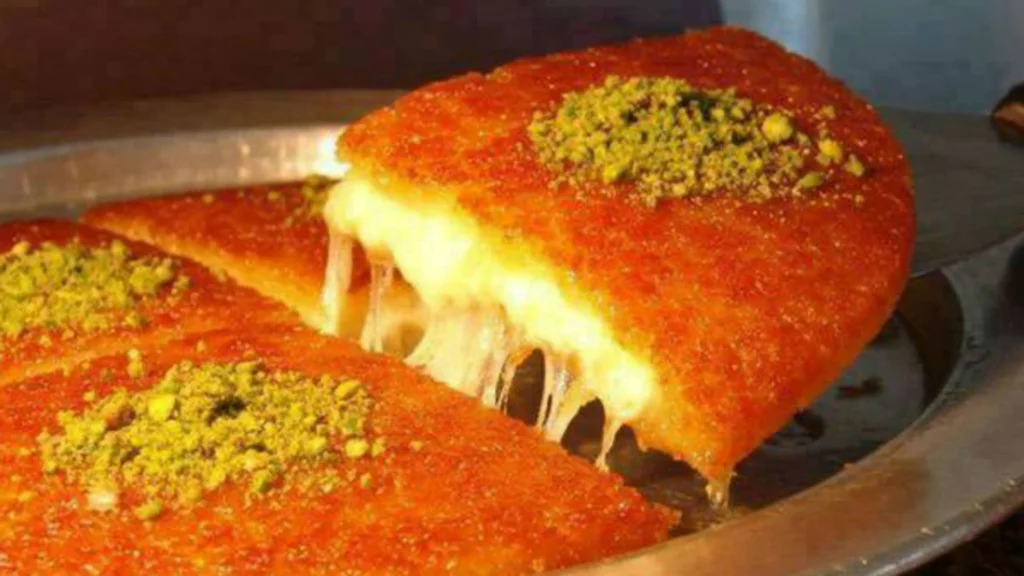
Knafeh (also spelled “kunafa,” “kunafeh,” or “knafe”) is a celebrated dessert throughout the Middle East, but it holds a special place in Palestinian cuisine, particularly in the city of Nablus. Nablus is so renowned for this dessert that it has its own variant, known as “Knafeh Nabulsieh.”
This dessert is made with thin noodle-like pastry or fine semolina dough soaked in sweet, sugar-based syrup, and layered with cheese, or sometimes with cream or nuts. With its crispy exterior, gooey interior, and a perfect blend of sweetness and richness, Knafeh has become synonymous with celebration, often enjoyed during festive occasions, family gatherings, and Ramadan iftars.
Traditional Palestinian Desserts – Ingredients for Knafeh
- 1 package (16 oz) of Knafeh dough (shredded phyllo dough)
- 2 cups unsalted cheese (like mozzarella or Nabulsi cheese), grated
- 1 cup unsalted butter, melted
- 1/2 cup fine semolina
- 1/4 cup granulated sugar
- 1/4 cup rose water or orange blossom water (optional)
- A pinch of salt
For the Syrup
- 1 cup granulated sugar
- 1/2 cup water
- 1 tsp lemon juice
- 1 tsp rose water or orange blossom water
Toppings (optional)
- Crushed pistachios
- Ground cinnamon
- Desiccated coconut
Traditional Palestinian Desserts – How to prepare Knafeh
Preparing the Syrup
In a saucepan, combine sugar, water, and lemon juice. Bring to a boil, then reduce heat and let it simmer until the sugar is dissolved.
Remove from heat and stir in the rose water or orange blossom water. Set aside to cool.
Prepping the Knafeh Dough
In a large mixing bowl, tear the Knafeh dough into shorter lengths. Add melted butter, semolina, sugar, and rose/orange blossom water. Mix until the dough strands are all evenly coated with butter.
Assembling the Knafeh
In a round baking tray or dish, spread half of the Knafeh dough mixture. Press it down firmly. Spread the grated cheese over the dough, ensuring an even layer. Cover the cheese with the remaining dough, pressing down gently.
Baking
Preheat your oven to 350°F (175°C). Bake the Knafeh for about 30-40 minutes or until the top is golden brown.
Finishing
Once out of the oven, immediately pour the cooled syrup over the hot Knafeh. Allow it to soak for a few minutes.
Serving
Flip the Knafeh onto a serving dish so that the crispy side is on top. Sprinkle with crushed pistachios, ground cinnamon, or desiccated coconut, if desired.
Presentation and Serving
Knafeh is best served warm, allowing the gooey cheese and crispy pastry to truly shine. It’s usually cut into square or diamond shapes and often accompanied by a cup of unsweetened tea to balance the sweetness.
Perfect Drink Pairing
The sweetness and richness of Knafeh pairs perfectly with unsweetened mint tea. The tea’s bitterness and the dessert’s sugariness complement each other, creating a harmonious tasting experience.
Knafeh is more than just a dessert in Palestinian culture; it’s a symbol of warmth, celebration, and the rich history of the region. With its golden threads, sumptuous cheese filling, and the embrace of fragrant syrup, Knafeh is a sensory journey that every lover of sweets must undertake. Whether you’re exploring Palestinian cuisine for the first time or revisiting familiar flavors, Knafeh is sure to captivate your heart and palate.
Traditional Palestinian Desserts – Ma’amoul

Ma’amoul is a traditional Middle Eastern shortbread cookie that is particularly popular in Palestinian cuisine. These ornate, handcrafted cookies are typically filled with dates, nuts, or figs and are a staple during religious holidays such as Eid al-Fitr, Eid al-Adha, and Christian holidays like Easter. The beautiful designs imprinted on the cookies, often using special wooden molds, not only make them visually appealing but also signify the type of filling inside. The name “Ma’amoul” translates to “filled” in Arabic, perfectly describing these delightful, stuffed cookies.
Traditional Palestinian Desserts – Ingredients for Ma’amoul
Dough
- 3 cups semolina (fine or coarse)
- 1 cup all-purpose flour
- 1 1/4 cups unsalted butter, melted
- 1/4 cup granulated sugar
- 1/4 cup milk or water, as needed
- 1 tsp orange blossom water (optional)
- 1 tsp rose water (optional)
Date Filling
- 2 cups pitted dates
- 1 tbsp unsalted butter
- 1 tsp ground cinnamon (optional)
- 1 tsp orange blossom water (optional)
Walnut Filling (optional alternative)
- 1 cup walnuts, finely chopped
- 1/4 cup granulated sugar
- 1 tsp orange blossom water (optional)
- 1 tsp rose water (optional)
Dusting
- Powdered sugar
Traditional Palestinian Desserts – How to prepare Ma’amoul
Preparing the Dough
In a large mixing bowl, combine the semolina, all-purpose flour, and sugar. Gradually add the melted butter and mix until the mixture resembles coarse breadcrumbs.
Add the orange blossom water, rose water, and milk (or water) as needed to form a soft dough. Cover and let it rest for an hour.
Preparing the Date Filling
In a food processor, combine the pitted dates, butter, cinnamon, and orange blossom water. Process until you get a smooth, pliable paste.
Assembling the Ma’amoul
Take a small amount of dough and flatten it in the palm of your hand. Place a small amount of date filling (or walnut filling) in the center. Fold the dough over the filling and seal the edges, forming a smooth ball.
If you have a Ma’amoul mold, press the ball into the mold to imprint the design, then tap out the cookie. If you don’t have a mold, you can decorate with a fork or simply leave them smooth.
Baking
Preheat your oven to 350°F (175°C). Place the Ma’amoul cookies on a baking sheet lined with parchment paper, ensuring they are spaced out. Bake for 15-20 minutes or until they are lightly golden.
Serving
Once cooled, dust the Ma’amoul cookies with powdered sugar.
Presentation and Serving
Ma’amoul cookies are usually served on a platter, dusted with a generous amount of powdered sugar. Their intricate designs make them stand out, making them the perfect centerpiece for festive gatherings.
Perfect Drink Pairing
Ma’amoul cookies pair wonderfully with Arabic coffee or mint tea. The slight bitterness of the coffee or the freshness of the mint tea complements the sweetness of the cookies, enhancing the overall tasting experience.
Ma’amoul is not just a cookie; it’s a symbol of celebration, tradition, and the rich mosaic of Palestinian culture. The meticulous process of preparing and molding each cookie tells a story of heritage, family gatherings, and the joy of shared moments. When you bite into a Ma’amoul, you’re not just tasting a cookie – you’re partaking in a centuries-old tradition that continues to be cherished to this day.
Conclusion
Palestinian cuisine is a vibrant tapestry of flavors, stories, and traditions. Each dish, from the starters to the desserts, tells a tale of a land rich in history and a people resilient in spirit. As you embark on this culinary journey, remember that every bite is a celebration of Palestinian heritage and an ode to its timeless culture.
FAQ’s
What is the staple ingredient in Palestinian cuisine
Olive oil, used generously in many dishes.
What is the Typical Palestinian Food?
Typical Palestinian food includes a variety of flavorful dishes. Some popular examples are maqluba, a rice and meat dish served with yogurt, and musakhan, a chicken and bread dish seasoned with sumac and onions.
Other staples include falafel, hummus, and tabbouleh. Palestinian cuisine often features fresh ingredients and aromatic spices.
Palestinian National Dish
Mansaf is the Palestinian national dish. It is a traditional Jordanian dish consisting of lamb cooked in a yogurt sauce, served over rice and topped with pine nuts and parsley.
Mansaf is often enjoyed during special occasions and celebrations, symbolizing the rich cultural heritage of the Palestinian people.
Traditional Palestinian Food
Traditional Palestinian food reflects the rich cultural heritage and flavors of the region. It includes dishes like maqluba (upside-down rice), musakhan (roasted chicken with sumac), and falafel (deep-fried chickpea patties).
These dishes are known for their use of aromatic spices, fresh vegetables, and wholesome ingredients, making them a delightful culinary experience.
Are vegetarian options prevalent in Palestinian food?
Absolutely! Dishes like hummus, tabouleh, and falafel are all vegetarian.
How is Palestinian cuisine different from other Middle Eastern cuisines?
While there are similarities, Palestinian cuisine has unique dishes and flavors, deeply rooted in its local produce and history.
What’s the significance of olive oil in Palestinian dishes?
Olive trees are abundant in Palestine. The oil symbolizes the land, its fertility, and the connection of the people to their land.
Why are communal meals significant in Palestinian culture?
Communal meals strengthen family bonds and symbolize unity, hospitality, and shared history.
Is bread an essential part of Palestinian meals?
Yes, bread, especially flatbreads like pita, are central to many Palestinian dishes and meals.

